Ship Design and System Integration
VerifiedAdded on 2023/04/08
|27
|6177
|206
AI Summary
This document provides an overview of ship design and system integration in the field of naval architecture and marine engineering. It discusses the challenges faced by ship architects and system integrators, the factors and requirements involved in ship design, and the importance of cooperation between designers, customers, yards, and equipment suppliers. The document also covers topics such as engineering drawing, ship structure and construction, hydrostatics, ship stability, ship resistance, ship propulsion, sea keeping and maneuvering, marine machinery and system design, marine engines and air conditioning, and the ship design process.
Contribute Materials
Your contribution can guide someone’s learning journey. Share your
documents today.
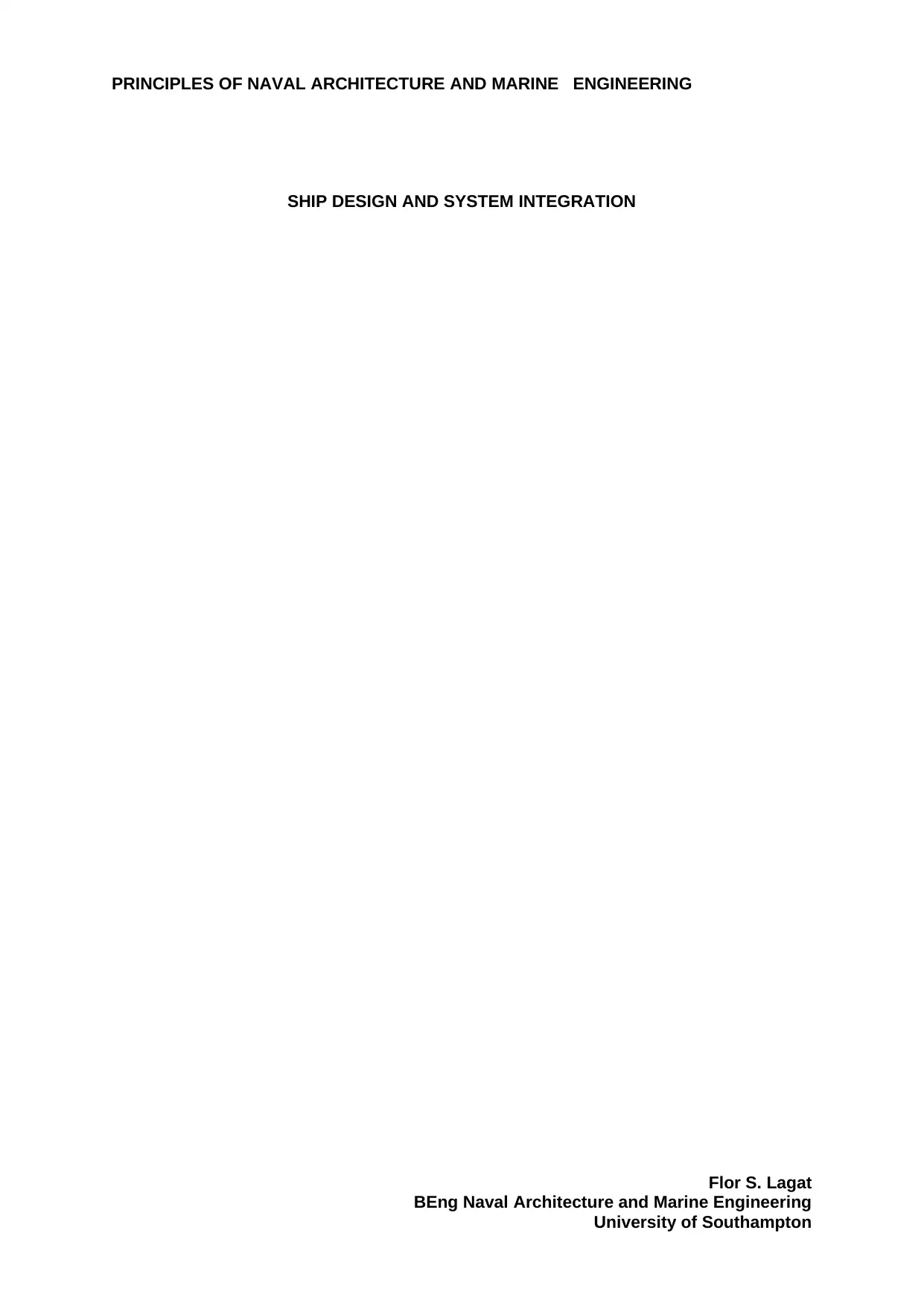
PRINCIPLES OF NAVAL ARCHITECTURE AND MARINE ENGINEERING
SHIP DESIGN AND SYSTEM INTEGRATION
Flor S. Lagat
BEng Naval Architecture and Marine Engineering
University of Southampton
SHIP DESIGN AND SYSTEM INTEGRATION
Flor S. Lagat
BEng Naval Architecture and Marine Engineering
University of Southampton
Secure Best Marks with AI Grader
Need help grading? Try our AI Grader for instant feedback on your assignments.
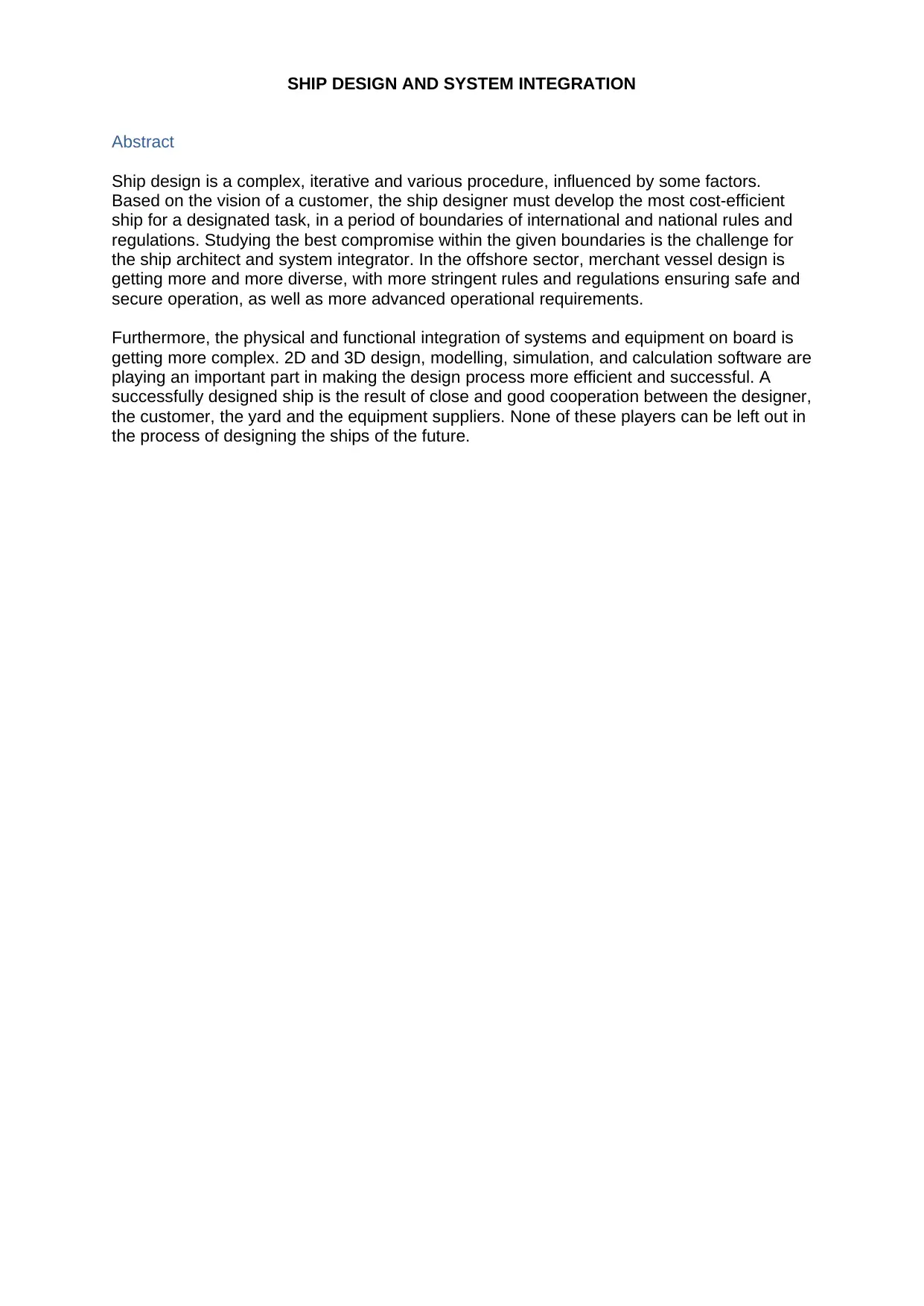
SHIP DESIGN AND SYSTEM INTEGRATION
Abstract
Ship design is a complex, iterative and various procedure, influenced by some factors.
Based on the vision of a customer, the ship designer must develop the most cost-efficient
ship for a designated task, in a period of boundaries of international and national rules and
regulations. Studying the best compromise within the given boundaries is the challenge for
the ship architect and system integrator. In the offshore sector, merchant vessel design is
getting more and more diverse, with more stringent rules and regulations ensuring safe and
secure operation, as well as more advanced operational requirements.
Furthermore, the physical and functional integration of systems and equipment on board is
getting more complex. 2D and 3D design, modelling, simulation, and calculation software are
playing an important part in making the design process more efficient and successful. A
successfully designed ship is the result of close and good cooperation between the designer,
the customer, the yard and the equipment suppliers. None of these players can be left out in
the process of designing the ships of the future.
Abstract
Ship design is a complex, iterative and various procedure, influenced by some factors.
Based on the vision of a customer, the ship designer must develop the most cost-efficient
ship for a designated task, in a period of boundaries of international and national rules and
regulations. Studying the best compromise within the given boundaries is the challenge for
the ship architect and system integrator. In the offshore sector, merchant vessel design is
getting more and more diverse, with more stringent rules and regulations ensuring safe and
secure operation, as well as more advanced operational requirements.
Furthermore, the physical and functional integration of systems and equipment on board is
getting more complex. 2D and 3D design, modelling, simulation, and calculation software are
playing an important part in making the design process more efficient and successful. A
successfully designed ship is the result of close and good cooperation between the designer,
the customer, the yard and the equipment suppliers. None of these players can be left out in
the process of designing the ships of the future.
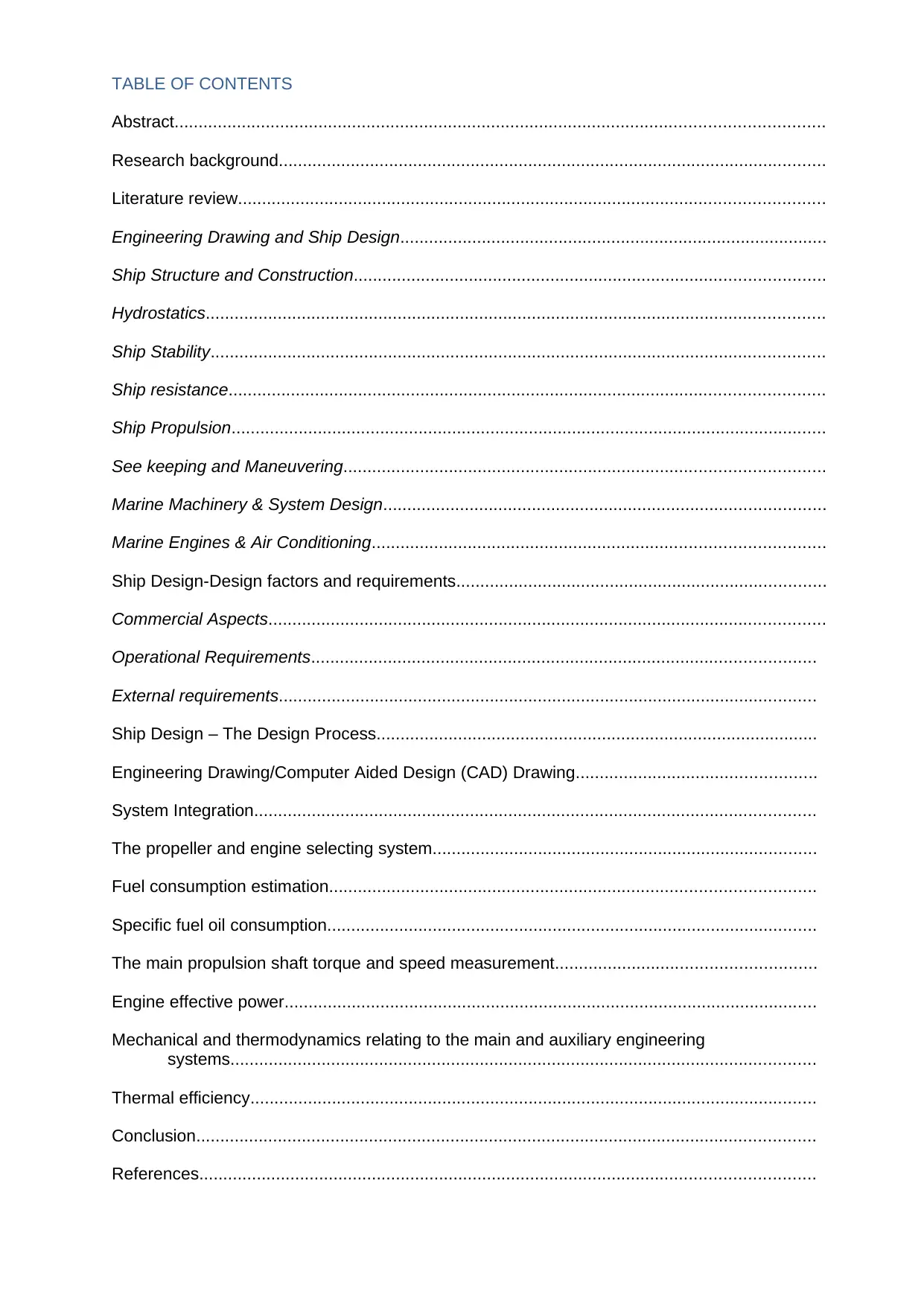
TABLE OF CONTENTS
Abstract.......................................................................................................................................
Research background..................................................................................................................
Literature review..........................................................................................................................
Engineering Drawing and Ship Design.........................................................................................
Ship Structure and Construction..................................................................................................
Hydrostatics.................................................................................................................................
Ship Stability................................................................................................................................
Ship resistance............................................................................................................................
Ship Propulsion............................................................................................................................
See keeping and Maneuvering....................................................................................................
Marine Machinery & System Design............................................................................................
Marine Engines & Air Conditioning..............................................................................................
Ship Design-Design factors and requirements.............................................................................
Commercial Aspects....................................................................................................................
Operational Requirements.........................................................................................................
External requirements................................................................................................................
Ship Design – The Design Process............................................................................................
Engineering Drawing/Computer Aided Design (CAD) Drawing..................................................
System Integration.....................................................................................................................
The propeller and engine selecting system................................................................................
Fuel consumption estimation.....................................................................................................
Specific fuel oil consumption......................................................................................................
The main propulsion shaft torque and speed measurement......................................................
Engine effective power...............................................................................................................
Mechanical and thermodynamics relating to the main and auxiliary engineering
systems..........................................................................................................................
Thermal efficiency......................................................................................................................
Conclusion.................................................................................................................................
References................................................................................................................................
Abstract.......................................................................................................................................
Research background..................................................................................................................
Literature review..........................................................................................................................
Engineering Drawing and Ship Design.........................................................................................
Ship Structure and Construction..................................................................................................
Hydrostatics.................................................................................................................................
Ship Stability................................................................................................................................
Ship resistance............................................................................................................................
Ship Propulsion............................................................................................................................
See keeping and Maneuvering....................................................................................................
Marine Machinery & System Design............................................................................................
Marine Engines & Air Conditioning..............................................................................................
Ship Design-Design factors and requirements.............................................................................
Commercial Aspects....................................................................................................................
Operational Requirements.........................................................................................................
External requirements................................................................................................................
Ship Design – The Design Process............................................................................................
Engineering Drawing/Computer Aided Design (CAD) Drawing..................................................
System Integration.....................................................................................................................
The propeller and engine selecting system................................................................................
Fuel consumption estimation.....................................................................................................
Specific fuel oil consumption......................................................................................................
The main propulsion shaft torque and speed measurement......................................................
Engine effective power...............................................................................................................
Mechanical and thermodynamics relating to the main and auxiliary engineering
systems..........................................................................................................................
Thermal efficiency......................................................................................................................
Conclusion.................................................................................................................................
References................................................................................................................................
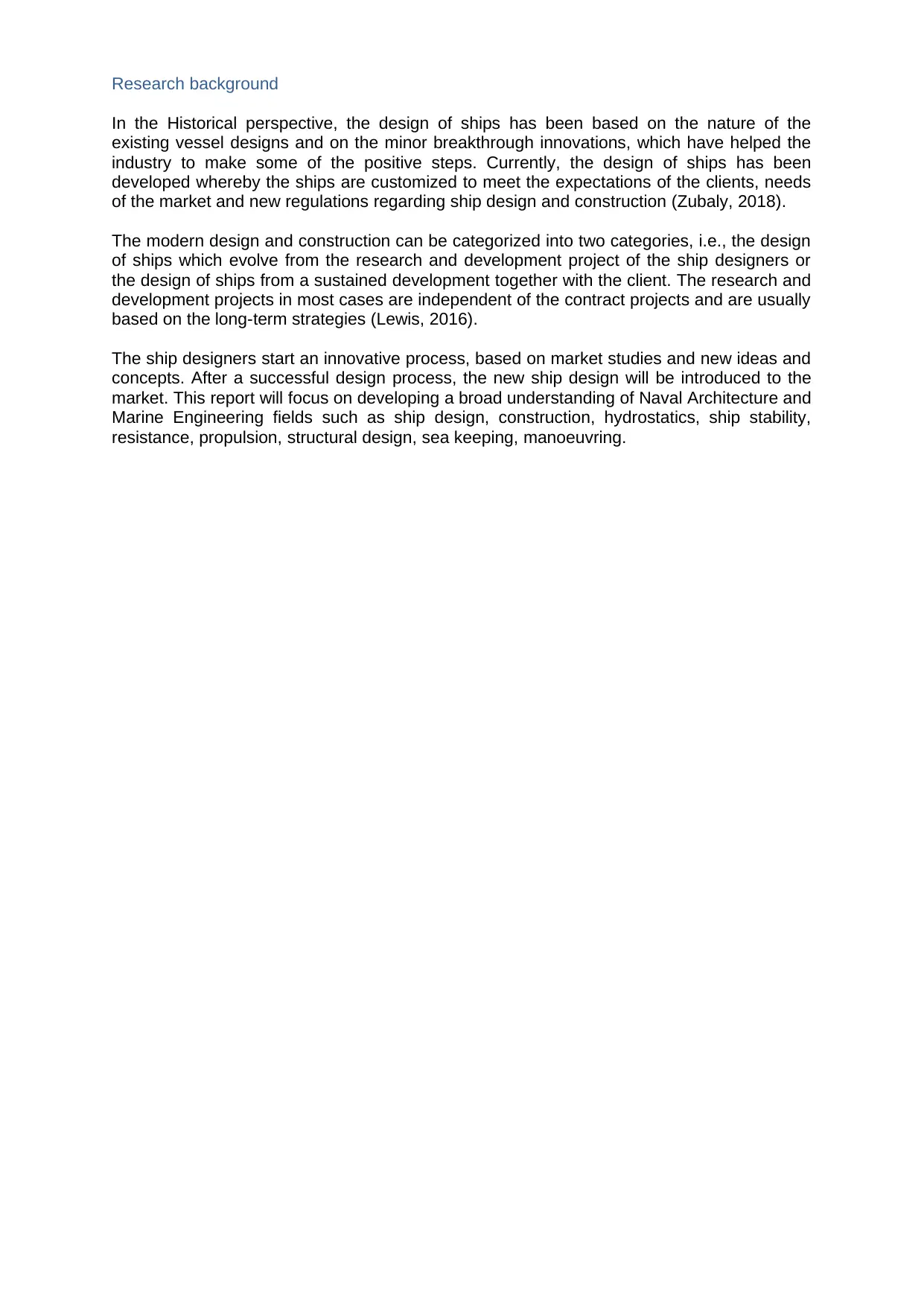
Research background
In the Historical perspective, the design of ships has been based on the nature of the
existing vessel designs and on the minor breakthrough innovations, which have helped the
industry to make some of the positive steps. Currently, the design of ships has been
developed whereby the ships are customized to meet the expectations of the clients, needs
of the market and new regulations regarding ship design and construction (Zubaly, 2018).
The modern design and construction can be categorized into two categories, i.e., the design
of ships which evolve from the research and development project of the ship designers or
the design of ships from a sustained development together with the client. The research and
development projects in most cases are independent of the contract projects and are usually
based on the long-term strategies (Lewis, 2016).
The ship designers start an innovative process, based on market studies and new ideas and
concepts. After a successful design process, the new ship design will be introduced to the
market. This report will focus on developing a broad understanding of Naval Architecture and
Marine Engineering fields such as ship design, construction, hydrostatics, ship stability,
resistance, propulsion, structural design, sea keeping, manoeuvring.
In the Historical perspective, the design of ships has been based on the nature of the
existing vessel designs and on the minor breakthrough innovations, which have helped the
industry to make some of the positive steps. Currently, the design of ships has been
developed whereby the ships are customized to meet the expectations of the clients, needs
of the market and new regulations regarding ship design and construction (Zubaly, 2018).
The modern design and construction can be categorized into two categories, i.e., the design
of ships which evolve from the research and development project of the ship designers or
the design of ships from a sustained development together with the client. The research and
development projects in most cases are independent of the contract projects and are usually
based on the long-term strategies (Lewis, 2016).
The ship designers start an innovative process, based on market studies and new ideas and
concepts. After a successful design process, the new ship design will be introduced to the
market. This report will focus on developing a broad understanding of Naval Architecture and
Marine Engineering fields such as ship design, construction, hydrostatics, ship stability,
resistance, propulsion, structural design, sea keeping, manoeuvring.
Secure Best Marks with AI Grader
Need help grading? Try our AI Grader for instant feedback on your assignments.
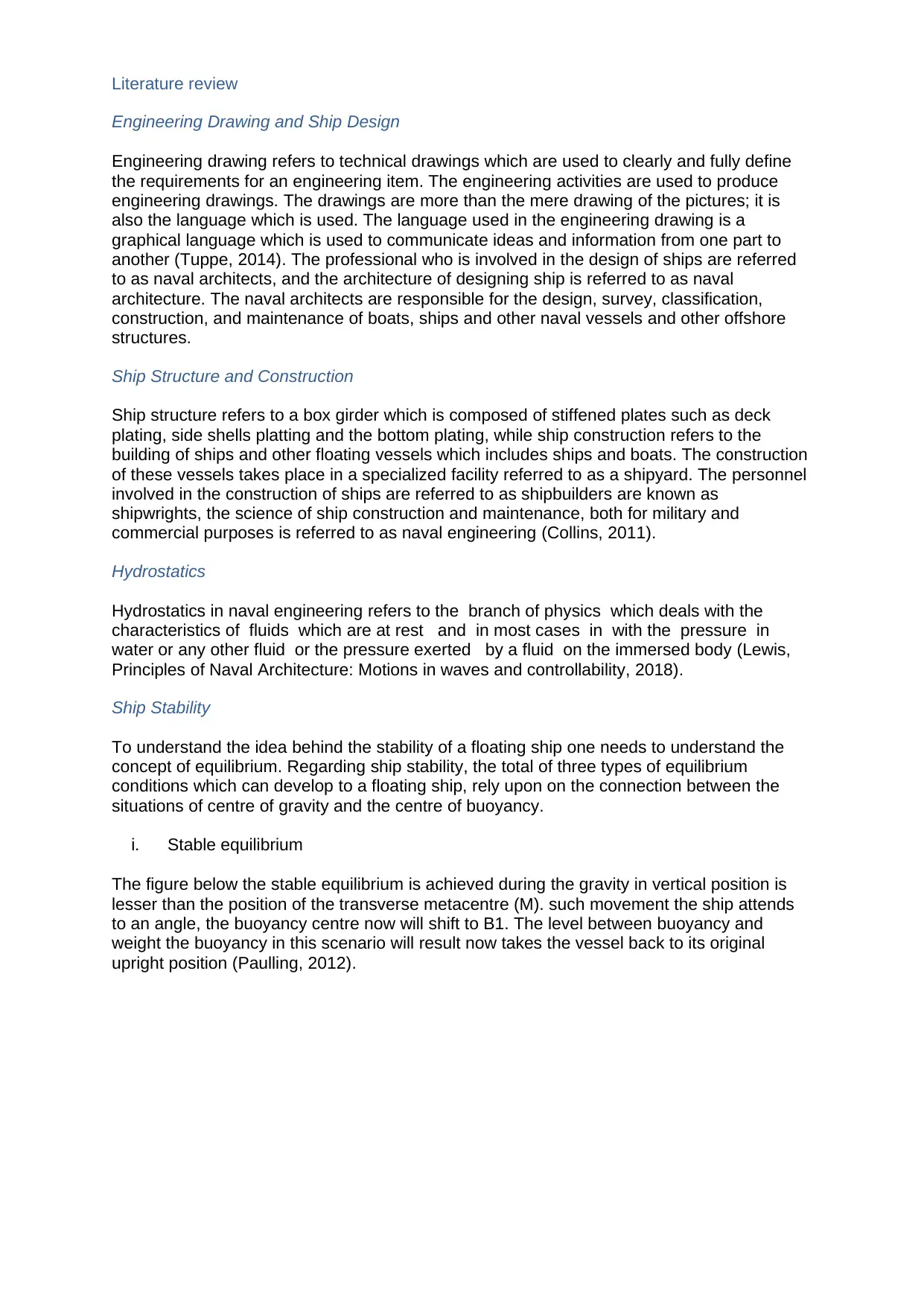
Literature review
Engineering Drawing and Ship Design
Engineering drawing refers to technical drawings which are used to clearly and fully define
the requirements for an engineering item. The engineering activities are used to produce
engineering drawings. The drawings are more than the mere drawing of the pictures; it is
also the language which is used. The language used in the engineering drawing is a
graphical language which is used to communicate ideas and information from one part to
another (Tuppe, 2014). The professional who is involved in the design of ships are referred
to as naval architects, and the architecture of designing ship is referred to as naval
architecture. The naval architects are responsible for the design, survey, classification,
construction, and maintenance of boats, ships and other naval vessels and other offshore
structures.
Ship Structure and Construction
Ship structure refers to a box girder which is composed of stiffened plates such as deck
plating, side shells platting and the bottom plating, while ship construction refers to the
building of ships and other floating vessels which includes ships and boats. The construction
of these vessels takes place in a specialized facility referred to as a shipyard. The personnel
involved in the construction of ships are referred to as shipbuilders are known as
shipwrights, the science of ship construction and maintenance, both for military and
commercial purposes is referred to as naval engineering (Collins, 2011).
Hydrostatics
Hydrostatics in naval engineering refers to the branch of physics which deals with the
characteristics of fluids which are at rest and in most cases in with the pressure in
water or any other fluid or the pressure exerted by a fluid on the immersed body (Lewis,
Principles of Naval Architecture: Motions in waves and controllability, 2018).
Ship Stability
To understand the idea behind the stability of a floating ship one needs to understand the
concept of equilibrium. Regarding ship stability, the total of three types of equilibrium
conditions which can develop to a floating ship, rely upon on the connection between the
situations of centre of gravity and the centre of buoyancy.
i. Stable equilibrium
The figure below the stable equilibrium is achieved during the gravity in vertical position is
lesser than the position of the transverse metacentre (M). such movement the ship attends
to an angle, the buoyancy centre now will shift to B1. The level between buoyancy and
weight the buoyancy in this scenario will result now takes the vessel back to its original
upright position (Paulling, 2012).
Engineering Drawing and Ship Design
Engineering drawing refers to technical drawings which are used to clearly and fully define
the requirements for an engineering item. The engineering activities are used to produce
engineering drawings. The drawings are more than the mere drawing of the pictures; it is
also the language which is used. The language used in the engineering drawing is a
graphical language which is used to communicate ideas and information from one part to
another (Tuppe, 2014). The professional who is involved in the design of ships are referred
to as naval architects, and the architecture of designing ship is referred to as naval
architecture. The naval architects are responsible for the design, survey, classification,
construction, and maintenance of boats, ships and other naval vessels and other offshore
structures.
Ship Structure and Construction
Ship structure refers to a box girder which is composed of stiffened plates such as deck
plating, side shells platting and the bottom plating, while ship construction refers to the
building of ships and other floating vessels which includes ships and boats. The construction
of these vessels takes place in a specialized facility referred to as a shipyard. The personnel
involved in the construction of ships are referred to as shipbuilders are known as
shipwrights, the science of ship construction and maintenance, both for military and
commercial purposes is referred to as naval engineering (Collins, 2011).
Hydrostatics
Hydrostatics in naval engineering refers to the branch of physics which deals with the
characteristics of fluids which are at rest and in most cases in with the pressure in
water or any other fluid or the pressure exerted by a fluid on the immersed body (Lewis,
Principles of Naval Architecture: Motions in waves and controllability, 2018).
Ship Stability
To understand the idea behind the stability of a floating ship one needs to understand the
concept of equilibrium. Regarding ship stability, the total of three types of equilibrium
conditions which can develop to a floating ship, rely upon on the connection between the
situations of centre of gravity and the centre of buoyancy.
i. Stable equilibrium
The figure below the stable equilibrium is achieved during the gravity in vertical position is
lesser than the position of the transverse metacentre (M). such movement the ship attends
to an angle, the buoyancy centre now will shift to B1. The level between buoyancy and
weight the buoyancy in this scenario will result now takes the vessel back to its original
upright position (Paulling, 2012).
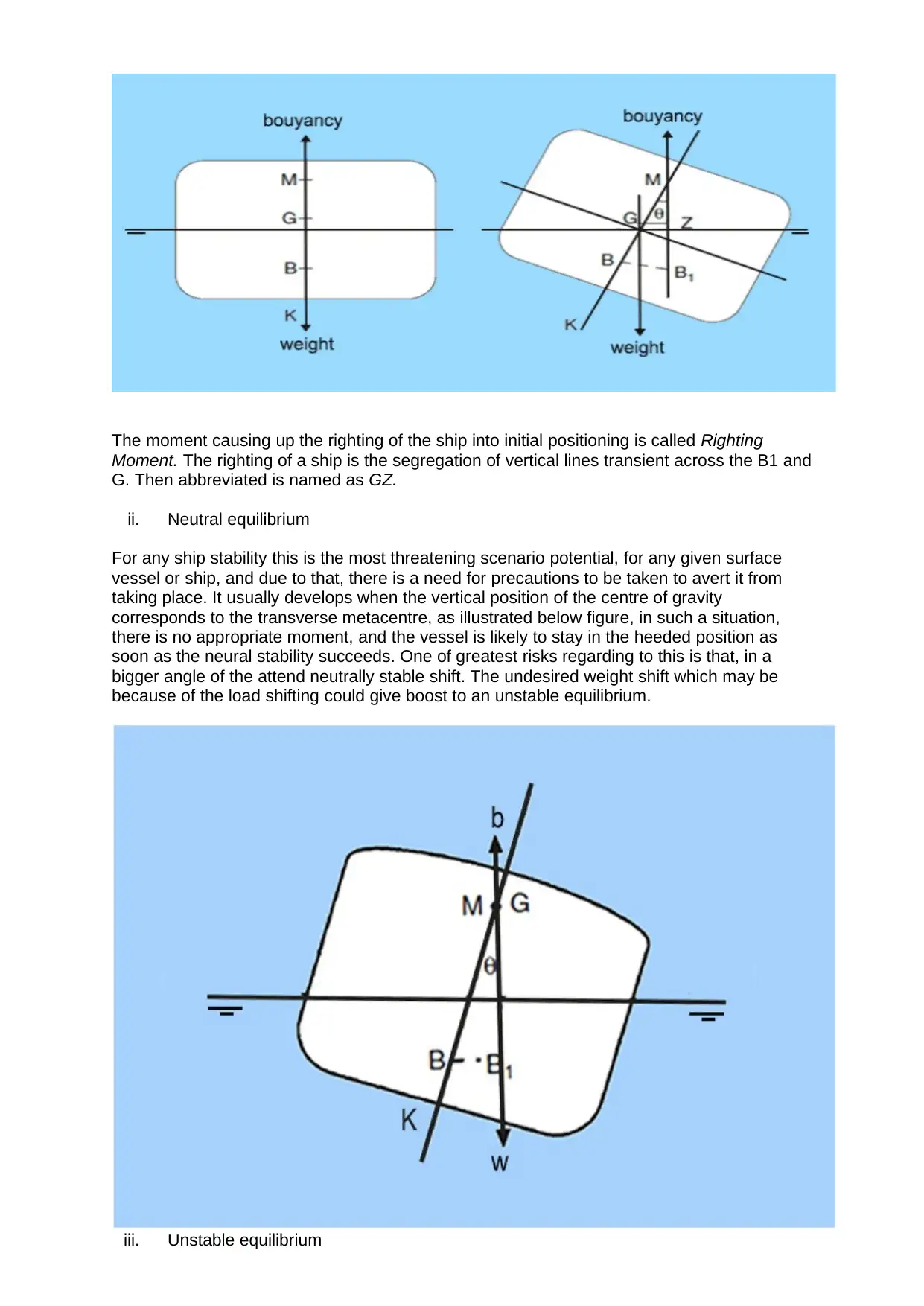
The moment causing up the righting of the ship into initial positioning is called Righting
Moment. The righting of a ship is the segregation of vertical lines transient across the B1 and
G. Then abbreviated is named as GZ.
ii. Neutral equilibrium
For any ship stability this is the most threatening scenario potential, for any given surface
vessel or ship, and due to that, there is a need for precautions to be taken to avert it from
taking place. It usually develops when the vertical position of the centre of gravity
corresponds to the transverse metacentre, as illustrated below figure, in such a situation,
there is no appropriate moment, and the vessel is likely to stay in the heeded position as
soon as the neural stability succeeds. One of greatest risks regarding to this is that, in a
bigger angle of the attend neutrally stable shift. The undesired weight shift which may be
because of the load shifting could give boost to an unstable equilibrium.
iii. Unstable equilibrium
Moment. The righting of a ship is the segregation of vertical lines transient across the B1 and
G. Then abbreviated is named as GZ.
ii. Neutral equilibrium
For any ship stability this is the most threatening scenario potential, for any given surface
vessel or ship, and due to that, there is a need for precautions to be taken to avert it from
taking place. It usually develops when the vertical position of the centre of gravity
corresponds to the transverse metacentre, as illustrated below figure, in such a situation,
there is no appropriate moment, and the vessel is likely to stay in the heeded position as
soon as the neural stability succeeds. One of greatest risks regarding to this is that, in a
bigger angle of the attend neutrally stable shift. The undesired weight shift which may be
because of the load shifting could give boost to an unstable equilibrium.
iii. Unstable equilibrium
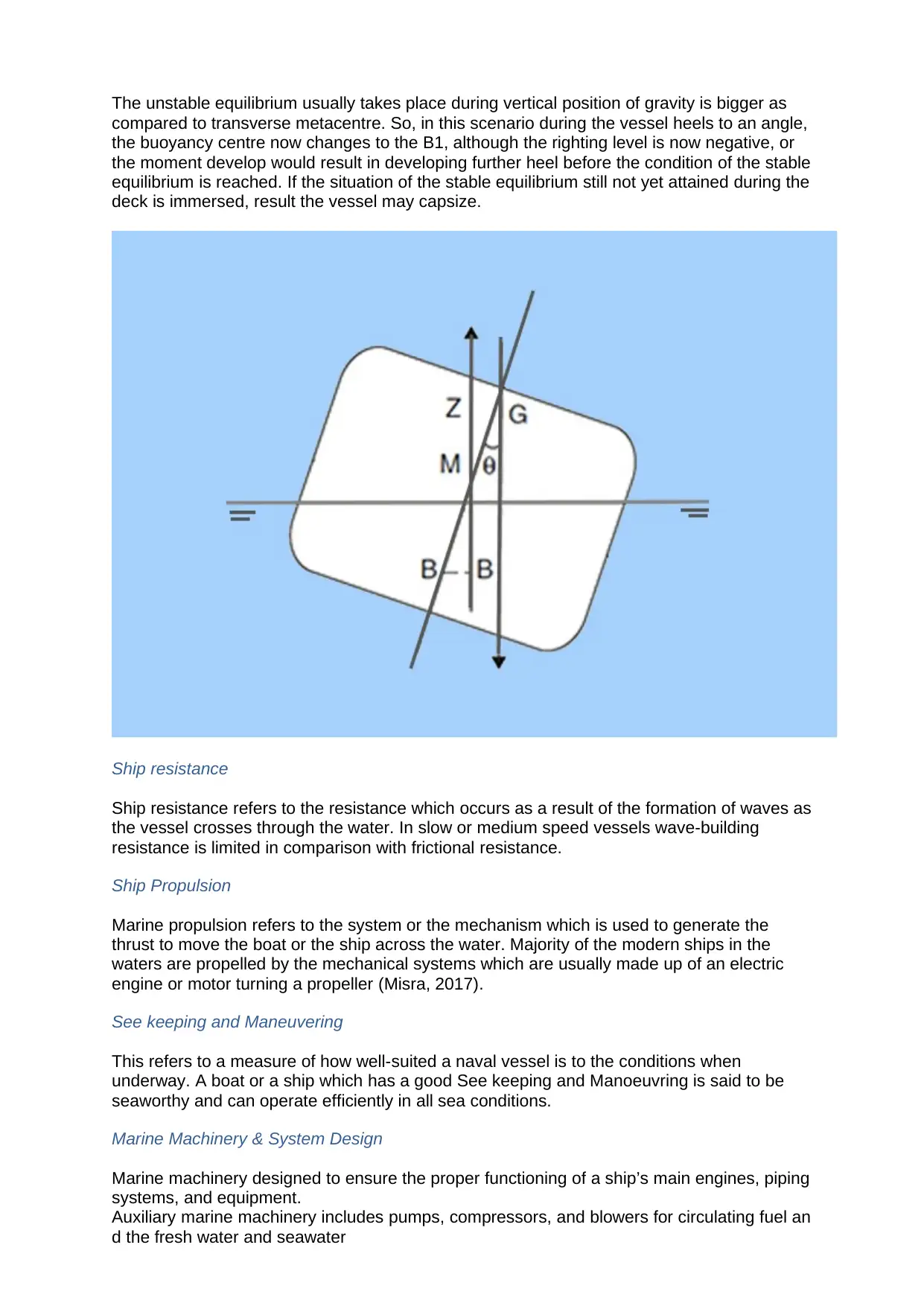
The unstable equilibrium usually takes place during vertical position of gravity is bigger as
compared to transverse metacentre. So, in this scenario during the vessel heels to an angle,
the buoyancy centre now changes to the B1, although the righting level is now negative, or
the moment develop would result in developing further heel before the condition of the stable
equilibrium is reached. If the situation of the stable equilibrium still not yet attained during the
deck is immersed, result the vessel may capsize.
Ship resistance
Ship resistance refers to the resistance which occurs as a result of the formation of waves as
the vessel crosses through the water. In slow or medium speed vessels wave-building
resistance is limited in comparison with frictional resistance.
Ship Propulsion
Marine propulsion refers to the system or the mechanism which is used to generate the
thrust to move the boat or the ship across the water. Majority of the modern ships in the
waters are propelled by the mechanical systems which are usually made up of an electric
engine or motor turning a propeller (Misra, 2017).
See keeping and Maneuvering
This refers to a measure of how well-suited a naval vessel is to the conditions when
underway. A boat or a ship which has a good See keeping and Manoeuvring is said to be
seaworthy and can operate efficiently in all sea conditions.
Marine Machinery & System Design
Marine machinery designed to ensure the proper functioning of a ship’s main engines, piping
systems, and equipment.
Auxiliary marine machinery includes pumps, compressors, and blowers for circulating fuel an
d the fresh water and seawater
compared to transverse metacentre. So, in this scenario during the vessel heels to an angle,
the buoyancy centre now changes to the B1, although the righting level is now negative, or
the moment develop would result in developing further heel before the condition of the stable
equilibrium is reached. If the situation of the stable equilibrium still not yet attained during the
deck is immersed, result the vessel may capsize.
Ship resistance
Ship resistance refers to the resistance which occurs as a result of the formation of waves as
the vessel crosses through the water. In slow or medium speed vessels wave-building
resistance is limited in comparison with frictional resistance.
Ship Propulsion
Marine propulsion refers to the system or the mechanism which is used to generate the
thrust to move the boat or the ship across the water. Majority of the modern ships in the
waters are propelled by the mechanical systems which are usually made up of an electric
engine or motor turning a propeller (Misra, 2017).
See keeping and Maneuvering
This refers to a measure of how well-suited a naval vessel is to the conditions when
underway. A boat or a ship which has a good See keeping and Manoeuvring is said to be
seaworthy and can operate efficiently in all sea conditions.
Marine Machinery & System Design
Marine machinery designed to ensure the proper functioning of a ship’s main engines, piping
systems, and equipment.
Auxiliary marine machinery includes pumps, compressors, and blowers for circulating fuel an
d the fresh water and seawater
Paraphrase This Document
Need a fresh take? Get an instant paraphrase of this document with our AI Paraphraser
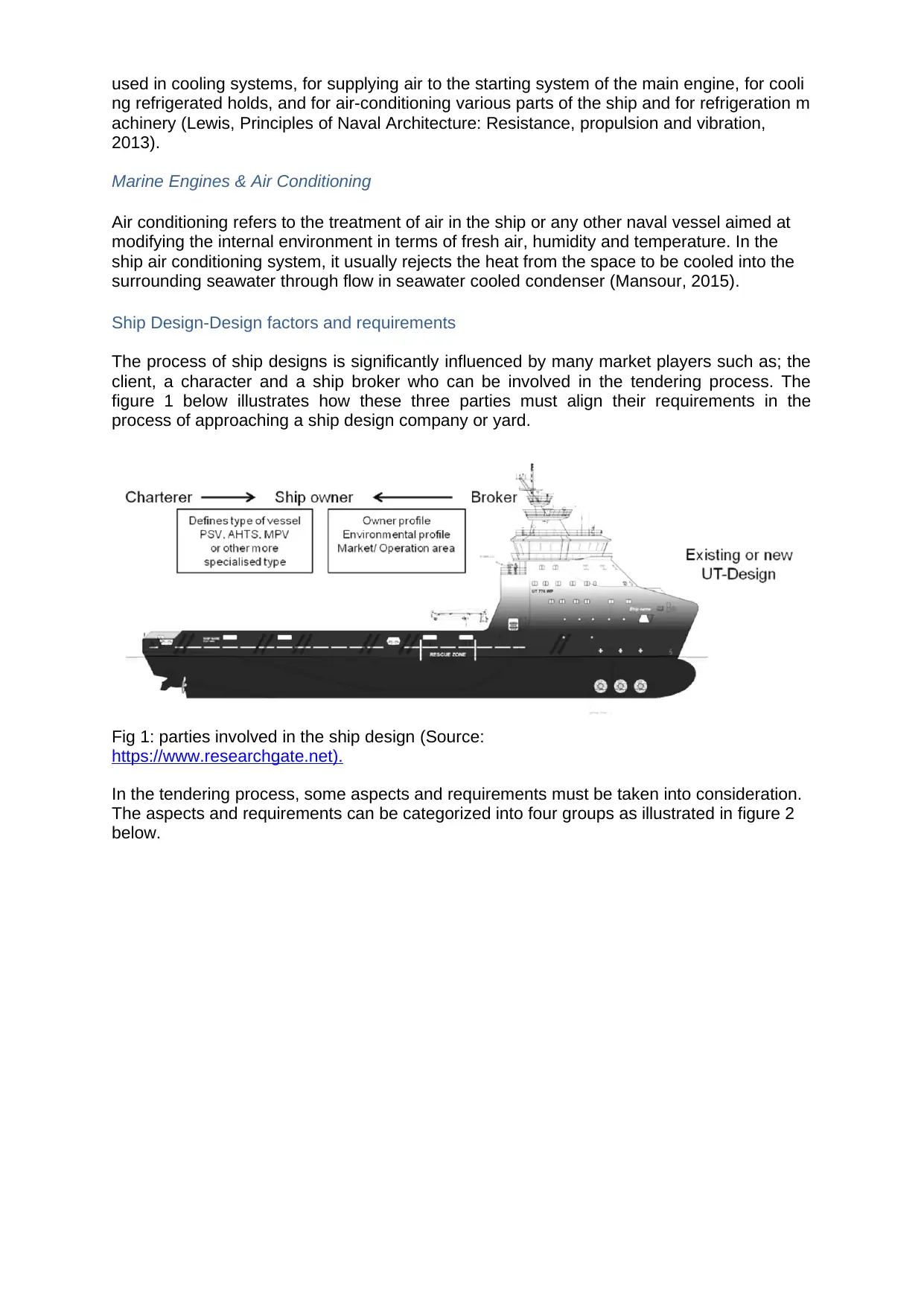
used in cooling systems, for supplying air to the starting system of the main engine, for cooli
ng refrigerated holds, and for air-conditioning various parts of the ship and for refrigeration m
achinery (Lewis, Principles of Naval Architecture: Resistance, propulsion and vibration,
2013).
Marine Engines & Air Conditioning
Air conditioning refers to the treatment of air in the ship or any other naval vessel aimed at
modifying the internal environment in terms of fresh air, humidity and temperature. In the
ship air conditioning system, it usually rejects the heat from the space to be cooled into the
surrounding seawater through flow in seawater cooled condenser (Mansour, 2015).
Ship Design-Design factors and requirements
The process of ship designs is significantly influenced by many market players such as; the
client, a character and a ship broker who can be involved in the tendering process. The
figure 1 below illustrates how these three parties must align their requirements in the
process of approaching a ship design company or yard.
Fig 1: parties involved in the ship design (Source:
https://www.researchgate.net).
In the tendering process, some aspects and requirements must be taken into consideration.
The aspects and requirements can be categorized into four groups as illustrated in figure 2
below.
ng refrigerated holds, and for air-conditioning various parts of the ship and for refrigeration m
achinery (Lewis, Principles of Naval Architecture: Resistance, propulsion and vibration,
2013).
Marine Engines & Air Conditioning
Air conditioning refers to the treatment of air in the ship or any other naval vessel aimed at
modifying the internal environment in terms of fresh air, humidity and temperature. In the
ship air conditioning system, it usually rejects the heat from the space to be cooled into the
surrounding seawater through flow in seawater cooled condenser (Mansour, 2015).
Ship Design-Design factors and requirements
The process of ship designs is significantly influenced by many market players such as; the
client, a character and a ship broker who can be involved in the tendering process. The
figure 1 below illustrates how these three parties must align their requirements in the
process of approaching a ship design company or yard.
Fig 1: parties involved in the ship design (Source:
https://www.researchgate.net).
In the tendering process, some aspects and requirements must be taken into consideration.
The aspects and requirements can be categorized into four groups as illustrated in figure 2
below.
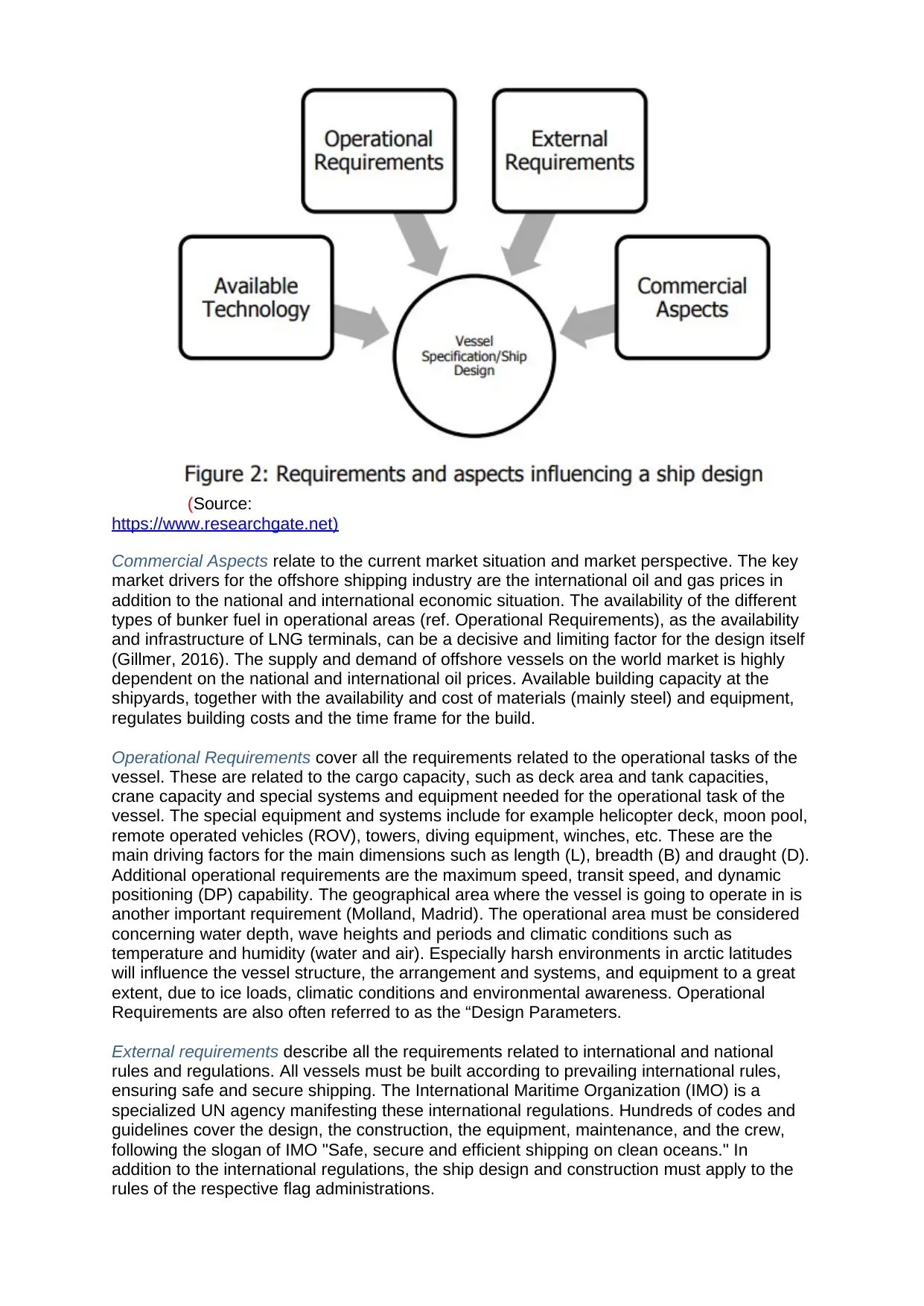
(Source:
https://www.researchgate.net)
Commercial Aspects relate to the current market situation and market perspective. The key
market drivers for the offshore shipping industry are the international oil and gas prices in
addition to the national and international economic situation. The availability of the different
types of bunker fuel in operational areas (ref. Operational Requirements), as the availability
and infrastructure of LNG terminals, can be a decisive and limiting factor for the design itself
(Gillmer, 2016). The supply and demand of offshore vessels on the world market is highly
dependent on the national and international oil prices. Available building capacity at the
shipyards, together with the availability and cost of materials (mainly steel) and equipment,
regulates building costs and the time frame for the build.
Operational Requirements cover all the requirements related to the operational tasks of the
vessel. These are related to the cargo capacity, such as deck area and tank capacities,
crane capacity and special systems and equipment needed for the operational task of the
vessel. The special equipment and systems include for example helicopter deck, moon pool,
remote operated vehicles (ROV), towers, diving equipment, winches, etc. These are the
main driving factors for the main dimensions such as length (L), breadth (B) and draught (D).
Additional operational requirements are the maximum speed, transit speed, and dynamic
positioning (DP) capability. The geographical area where the vessel is going to operate in is
another important requirement (Molland, Madrid). The operational area must be considered
concerning water depth, wave heights and periods and climatic conditions such as
temperature and humidity (water and air). Especially harsh environments in arctic latitudes
will influence the vessel structure, the arrangement and systems, and equipment to a great
extent, due to ice loads, climatic conditions and environmental awareness. Operational
Requirements are also often referred to as the “Design Parameters.
External requirements describe all the requirements related to international and national
rules and regulations. All vessels must be built according to prevailing international rules,
ensuring safe and secure shipping. The International Maritime Organization (IMO) is a
specialized UN agency manifesting these international regulations. Hundreds of codes and
guidelines cover the design, the construction, the equipment, maintenance, and the crew,
following the slogan of IMO "Safe, secure and efficient shipping on clean oceans." In
addition to the international regulations, the ship design and construction must apply to the
rules of the respective flag administrations.
https://www.researchgate.net)
Commercial Aspects relate to the current market situation and market perspective. The key
market drivers for the offshore shipping industry are the international oil and gas prices in
addition to the national and international economic situation. The availability of the different
types of bunker fuel in operational areas (ref. Operational Requirements), as the availability
and infrastructure of LNG terminals, can be a decisive and limiting factor for the design itself
(Gillmer, 2016). The supply and demand of offshore vessels on the world market is highly
dependent on the national and international oil prices. Available building capacity at the
shipyards, together with the availability and cost of materials (mainly steel) and equipment,
regulates building costs and the time frame for the build.
Operational Requirements cover all the requirements related to the operational tasks of the
vessel. These are related to the cargo capacity, such as deck area and tank capacities,
crane capacity and special systems and equipment needed for the operational task of the
vessel. The special equipment and systems include for example helicopter deck, moon pool,
remote operated vehicles (ROV), towers, diving equipment, winches, etc. These are the
main driving factors for the main dimensions such as length (L), breadth (B) and draught (D).
Additional operational requirements are the maximum speed, transit speed, and dynamic
positioning (DP) capability. The geographical area where the vessel is going to operate in is
another important requirement (Molland, Madrid). The operational area must be considered
concerning water depth, wave heights and periods and climatic conditions such as
temperature and humidity (water and air). Especially harsh environments in arctic latitudes
will influence the vessel structure, the arrangement and systems, and equipment to a great
extent, due to ice loads, climatic conditions and environmental awareness. Operational
Requirements are also often referred to as the “Design Parameters.
External requirements describe all the requirements related to international and national
rules and regulations. All vessels must be built according to prevailing international rules,
ensuring safe and secure shipping. The International Maritime Organization (IMO) is a
specialized UN agency manifesting these international regulations. Hundreds of codes and
guidelines cover the design, the construction, the equipment, maintenance, and the crew,
following the slogan of IMO "Safe, secure and efficient shipping on clean oceans." In
addition to the international regulations, the ship design and construction must apply to the
rules of the respective flag administrations.
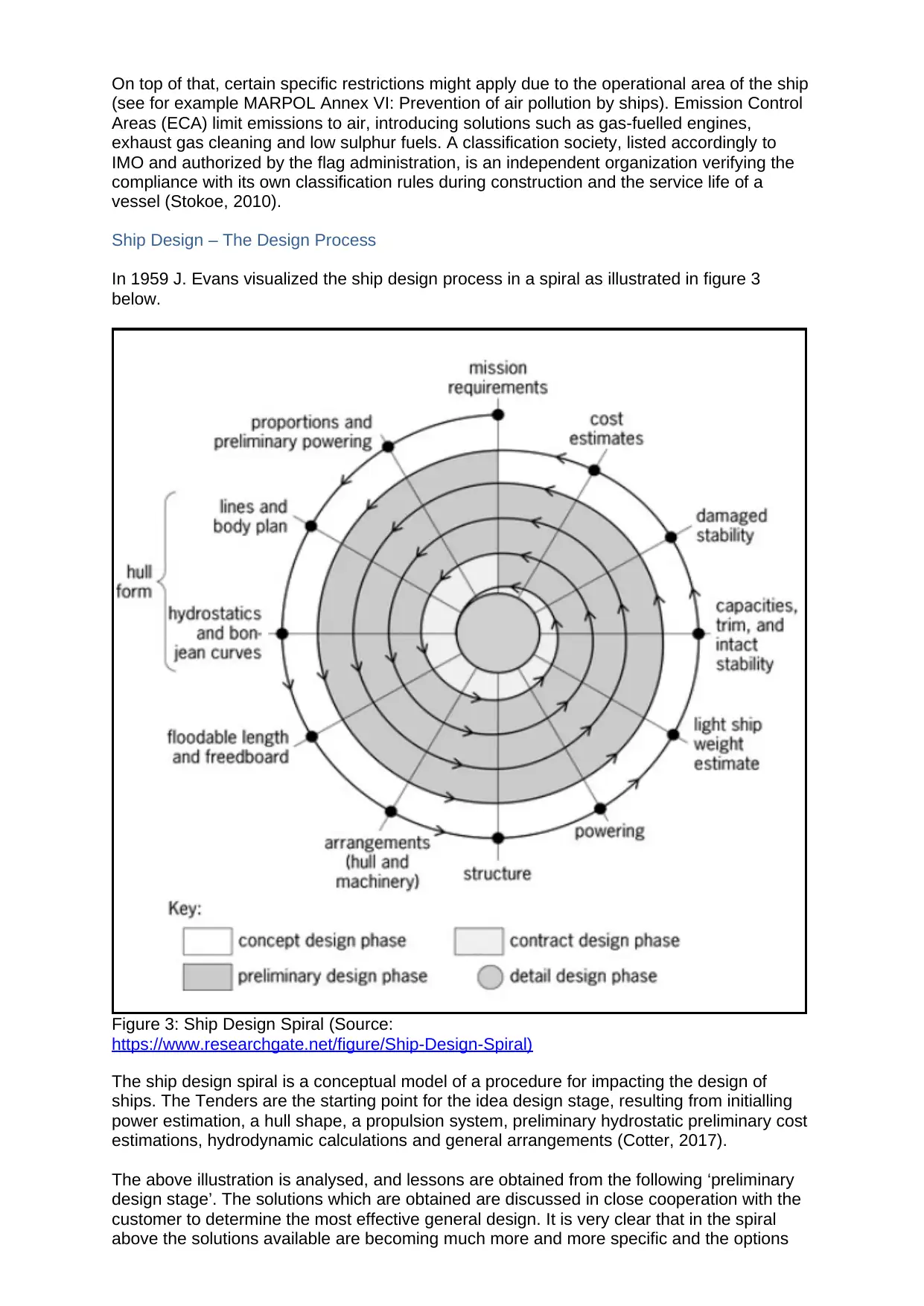
On top of that, certain specific restrictions might apply due to the operational area of the ship
(see for example MARPOL Annex VI: Prevention of air pollution by ships). Emission Control
Areas (ECA) limit emissions to air, introducing solutions such as gas-fuelled engines,
exhaust gas cleaning and low sulphur fuels. A classification society, listed accordingly to
IMO and authorized by the flag administration, is an independent organization verifying the
compliance with its own classification rules during construction and the service life of a
vessel (Stokoe, 2010).
Ship Design – The Design Process
In 1959 J. Evans visualized the ship design process in a spiral as illustrated in figure 3
below.
Figure 3: Ship Design Spiral (Source:
https://www.researchgate.net/figure/Ship-Design-Spiral)
The ship design spiral is a conceptual model of a procedure for impacting the design of
ships. The Tenders are the starting point for the idea design stage, resulting from initialling
power estimation, a hull shape, a propulsion system, preliminary hydrostatic preliminary cost
estimations, hydrodynamic calculations and general arrangements (Cotter, 2017).
The above illustration is analysed, and lessons are obtained from the following ‘preliminary
design stage’. The solutions which are obtained are discussed in close cooperation with the
customer to determine the most effective general design. It is very clear that in the spiral
above the solutions available are becoming much more and more specific and the options
(see for example MARPOL Annex VI: Prevention of air pollution by ships). Emission Control
Areas (ECA) limit emissions to air, introducing solutions such as gas-fuelled engines,
exhaust gas cleaning and low sulphur fuels. A classification society, listed accordingly to
IMO and authorized by the flag administration, is an independent organization verifying the
compliance with its own classification rules during construction and the service life of a
vessel (Stokoe, 2010).
Ship Design – The Design Process
In 1959 J. Evans visualized the ship design process in a spiral as illustrated in figure 3
below.
Figure 3: Ship Design Spiral (Source:
https://www.researchgate.net/figure/Ship-Design-Spiral)
The ship design spiral is a conceptual model of a procedure for impacting the design of
ships. The Tenders are the starting point for the idea design stage, resulting from initialling
power estimation, a hull shape, a propulsion system, preliminary hydrostatic preliminary cost
estimations, hydrodynamic calculations and general arrangements (Cotter, 2017).
The above illustration is analysed, and lessons are obtained from the following ‘preliminary
design stage’. The solutions which are obtained are discussed in close cooperation with the
customer to determine the most effective general design. It is very clear that in the spiral
above the solutions available are becoming much more and more specific and the options
Secure Best Marks with AI Grader
Need help grading? Try our AI Grader for instant feedback on your assignments.
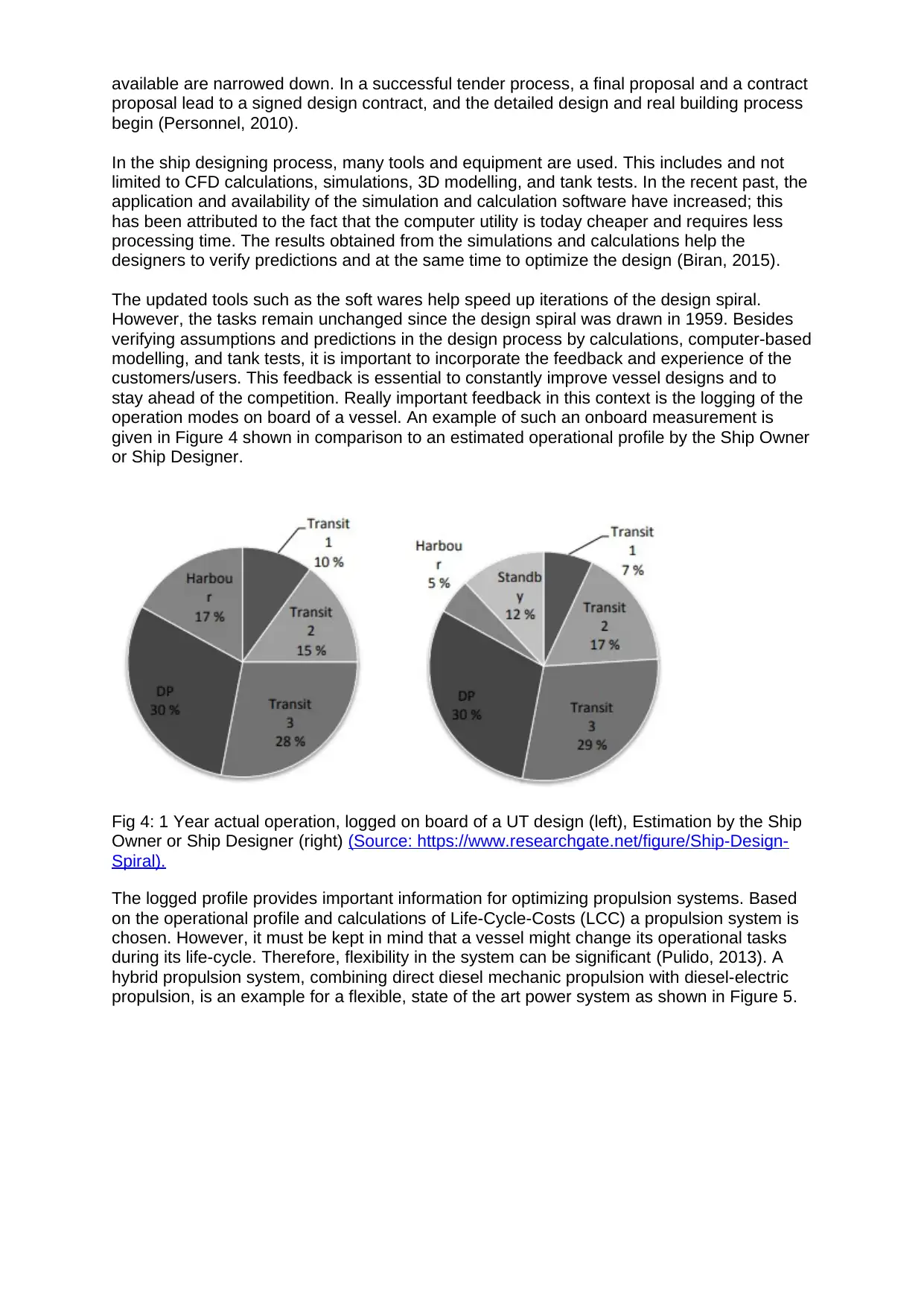
available are narrowed down. In a successful tender process, a final proposal and a contract
proposal lead to a signed design contract, and the detailed design and real building process
begin (Personnel, 2010).
In the ship designing process, many tools and equipment are used. This includes and not
limited to CFD calculations, simulations, 3D modelling, and tank tests. In the recent past, the
application and availability of the simulation and calculation software have increased; this
has been attributed to the fact that the computer utility is today cheaper and requires less
processing time. The results obtained from the simulations and calculations help the
designers to verify predictions and at the same time to optimize the design (Biran, 2015).
The updated tools such as the soft wares help speed up iterations of the design spiral.
However, the tasks remain unchanged since the design spiral was drawn in 1959. Besides
verifying assumptions and predictions in the design process by calculations, computer-based
modelling, and tank tests, it is important to incorporate the feedback and experience of the
customers/users. This feedback is essential to constantly improve vessel designs and to
stay ahead of the competition. Really important feedback in this context is the logging of the
operation modes on board of a vessel. An example of such an onboard measurement is
given in Figure 4 shown in comparison to an estimated operational profile by the Ship Owner
or Ship Designer.
Fig 4: 1 Year actual operation, logged on board of a UT design (left), Estimation by the Ship
Owner or Ship Designer (right) (Source: https://www.researchgate.net/figure/Ship-Design-
Spiral).
The logged profile provides important information for optimizing propulsion systems. Based
on the operational profile and calculations of Life-Cycle-Costs (LCC) a propulsion system is
chosen. However, it must be kept in mind that a vessel might change its operational tasks
during its life-cycle. Therefore, flexibility in the system can be significant (Pulido, 2013). A
hybrid propulsion system, combining direct diesel mechanic propulsion with diesel-electric
propulsion, is an example for a flexible, state of the art power system as shown in Figure 5.
proposal lead to a signed design contract, and the detailed design and real building process
begin (Personnel, 2010).
In the ship designing process, many tools and equipment are used. This includes and not
limited to CFD calculations, simulations, 3D modelling, and tank tests. In the recent past, the
application and availability of the simulation and calculation software have increased; this
has been attributed to the fact that the computer utility is today cheaper and requires less
processing time. The results obtained from the simulations and calculations help the
designers to verify predictions and at the same time to optimize the design (Biran, 2015).
The updated tools such as the soft wares help speed up iterations of the design spiral.
However, the tasks remain unchanged since the design spiral was drawn in 1959. Besides
verifying assumptions and predictions in the design process by calculations, computer-based
modelling, and tank tests, it is important to incorporate the feedback and experience of the
customers/users. This feedback is essential to constantly improve vessel designs and to
stay ahead of the competition. Really important feedback in this context is the logging of the
operation modes on board of a vessel. An example of such an onboard measurement is
given in Figure 4 shown in comparison to an estimated operational profile by the Ship Owner
or Ship Designer.
Fig 4: 1 Year actual operation, logged on board of a UT design (left), Estimation by the Ship
Owner or Ship Designer (right) (Source: https://www.researchgate.net/figure/Ship-Design-
Spiral).
The logged profile provides important information for optimizing propulsion systems. Based
on the operational profile and calculations of Life-Cycle-Costs (LCC) a propulsion system is
chosen. However, it must be kept in mind that a vessel might change its operational tasks
during its life-cycle. Therefore, flexibility in the system can be significant (Pulido, 2013). A
hybrid propulsion system, combining direct diesel mechanic propulsion with diesel-electric
propulsion, is an example for a flexible, state of the art power system as shown in Figure 5.
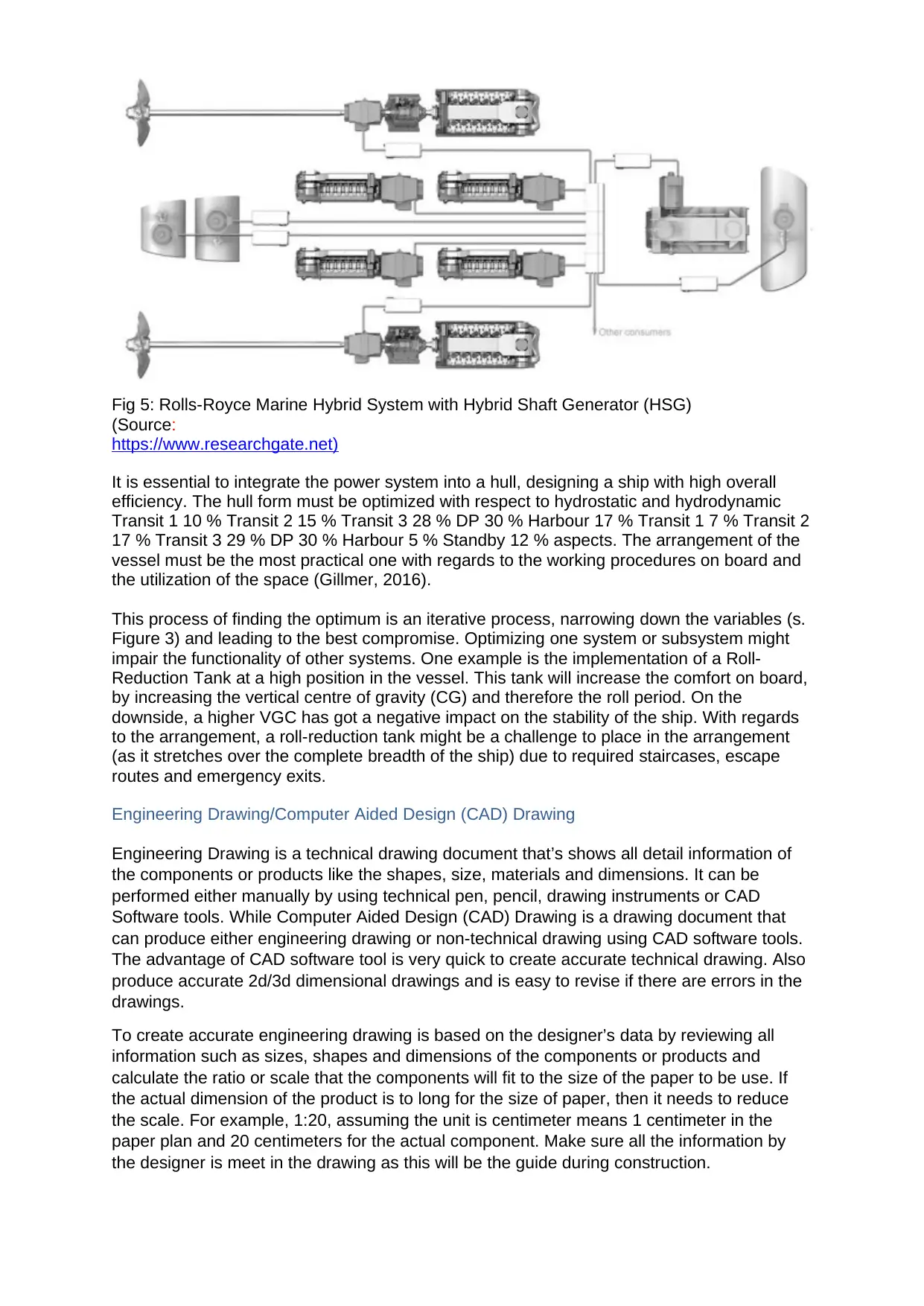
Fig 5: Rolls-Royce Marine Hybrid System with Hybrid Shaft Generator (HSG)
(Source:
https://www.researchgate.net)
It is essential to integrate the power system into a hull, designing a ship with high overall
efficiency. The hull form must be optimized with respect to hydrostatic and hydrodynamic
Transit 1 10 % Transit 2 15 % Transit 3 28 % DP 30 % Harbour 17 % Transit 1 7 % Transit 2
17 % Transit 3 29 % DP 30 % Harbour 5 % Standby 12 % aspects. The arrangement of the
vessel must be the most practical one with regards to the working procedures on board and
the utilization of the space (Gillmer, 2016).
This process of finding the optimum is an iterative process, narrowing down the variables (s.
Figure 3) and leading to the best compromise. Optimizing one system or subsystem might
impair the functionality of other systems. One example is the implementation of a Roll-
Reduction Tank at a high position in the vessel. This tank will increase the comfort on board,
by increasing the vertical centre of gravity (CG) and therefore the roll period. On the
downside, a higher VGC has got a negative impact on the stability of the ship. With regards
to the arrangement, a roll-reduction tank might be a challenge to place in the arrangement
(as it stretches over the complete breadth of the ship) due to required staircases, escape
routes and emergency exits.
Engineering Drawing/Computer Aided Design (CAD) Drawing
Engineering Drawing is a technical drawing document that’s shows all detail information of
the components or products like the shapes, size, materials and dimensions. It can be
performed either manually by using technical pen, pencil, drawing instruments or CAD
Software tools. While Computer Aided Design (CAD) Drawing is a drawing document that
can produce either engineering drawing or non-technical drawing using CAD software tools.
The advantage of CAD software tool is very quick to create accurate technical drawing. Also
produce accurate 2d/3d dimensional drawings and is easy to revise if there are errors in the
drawings.
To create accurate engineering drawing is based on the designer’s data by reviewing all
information such as sizes, shapes and dimensions of the components or products and
calculate the ratio or scale that the components will fit to the size of the paper to be use. If
the actual dimension of the product is to long for the size of paper, then it needs to reduce
the scale. For example, 1:20, assuming the unit is centimeter means 1 centimeter in the
paper plan and 20 centimeters for the actual component. Make sure all the information by
the designer is meet in the drawing as this will be the guide during construction.
(Source:
https://www.researchgate.net)
It is essential to integrate the power system into a hull, designing a ship with high overall
efficiency. The hull form must be optimized with respect to hydrostatic and hydrodynamic
Transit 1 10 % Transit 2 15 % Transit 3 28 % DP 30 % Harbour 17 % Transit 1 7 % Transit 2
17 % Transit 3 29 % DP 30 % Harbour 5 % Standby 12 % aspects. The arrangement of the
vessel must be the most practical one with regards to the working procedures on board and
the utilization of the space (Gillmer, 2016).
This process of finding the optimum is an iterative process, narrowing down the variables (s.
Figure 3) and leading to the best compromise. Optimizing one system or subsystem might
impair the functionality of other systems. One example is the implementation of a Roll-
Reduction Tank at a high position in the vessel. This tank will increase the comfort on board,
by increasing the vertical centre of gravity (CG) and therefore the roll period. On the
downside, a higher VGC has got a negative impact on the stability of the ship. With regards
to the arrangement, a roll-reduction tank might be a challenge to place in the arrangement
(as it stretches over the complete breadth of the ship) due to required staircases, escape
routes and emergency exits.
Engineering Drawing/Computer Aided Design (CAD) Drawing
Engineering Drawing is a technical drawing document that’s shows all detail information of
the components or products like the shapes, size, materials and dimensions. It can be
performed either manually by using technical pen, pencil, drawing instruments or CAD
Software tools. While Computer Aided Design (CAD) Drawing is a drawing document that
can produce either engineering drawing or non-technical drawing using CAD software tools.
The advantage of CAD software tool is very quick to create accurate technical drawing. Also
produce accurate 2d/3d dimensional drawings and is easy to revise if there are errors in the
drawings.
To create accurate engineering drawing is based on the designer’s data by reviewing all
information such as sizes, shapes and dimensions of the components or products and
calculate the ratio or scale that the components will fit to the size of the paper to be use. If
the actual dimension of the product is to long for the size of paper, then it needs to reduce
the scale. For example, 1:20, assuming the unit is centimeter means 1 centimeter in the
paper plan and 20 centimeters for the actual component. Make sure all the information by
the designer is meet in the drawing as this will be the guide during construction.
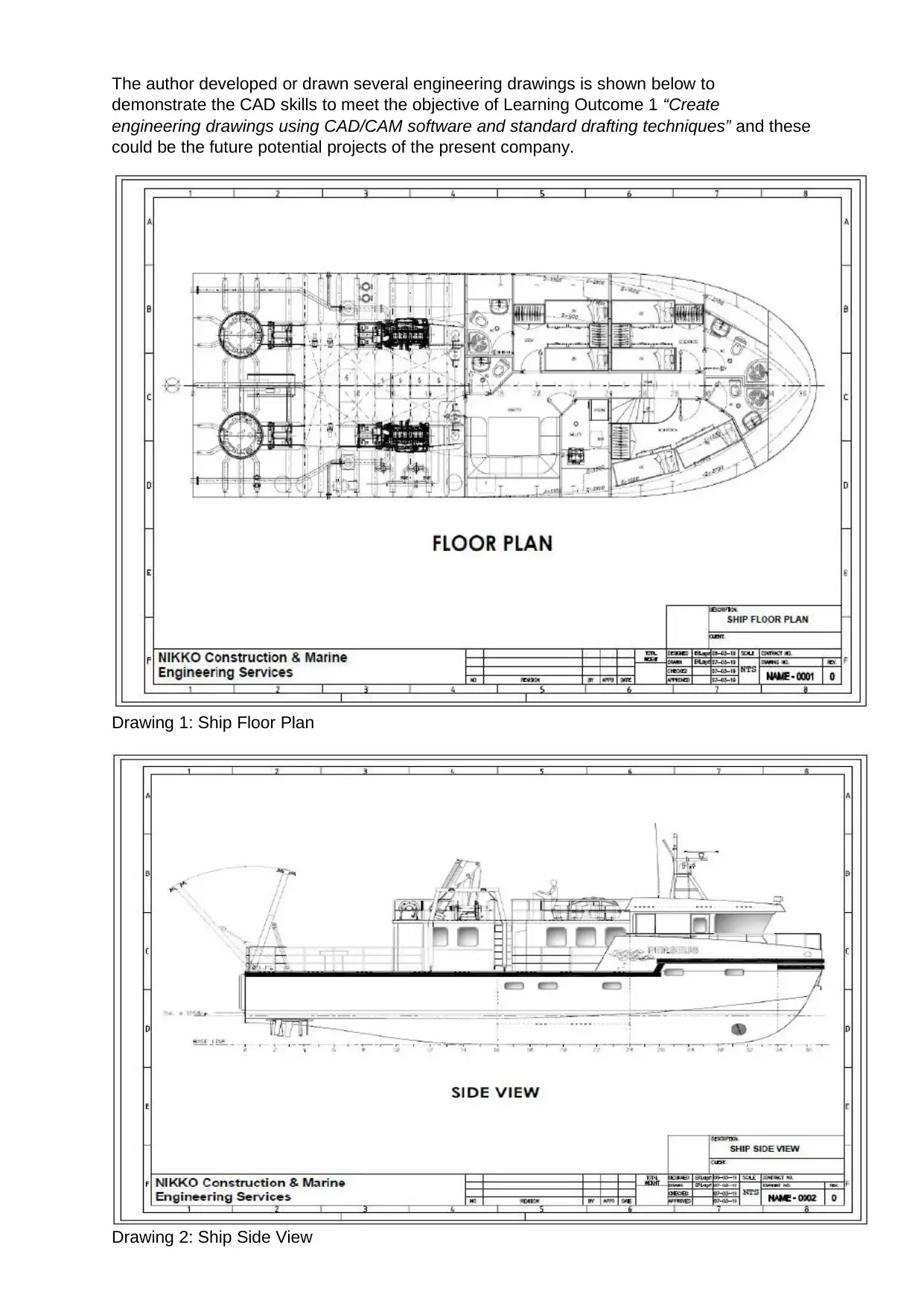
The author developed or drawn several engineering drawings is shown below to
demonstrate the CAD skills to meet the objective of Learning Outcome 1 “Create
engineering drawings using CAD/CAM software and standard drafting techniques” and these
could be the future potential projects of the present company.
Drawing 1: Ship Floor Plan
Drawing 2: Ship Side View
demonstrate the CAD skills to meet the objective of Learning Outcome 1 “Create
engineering drawings using CAD/CAM software and standard drafting techniques” and these
could be the future potential projects of the present company.
Drawing 1: Ship Floor Plan
Drawing 2: Ship Side View
Paraphrase This Document
Need a fresh take? Get an instant paraphrase of this document with our AI Paraphraser
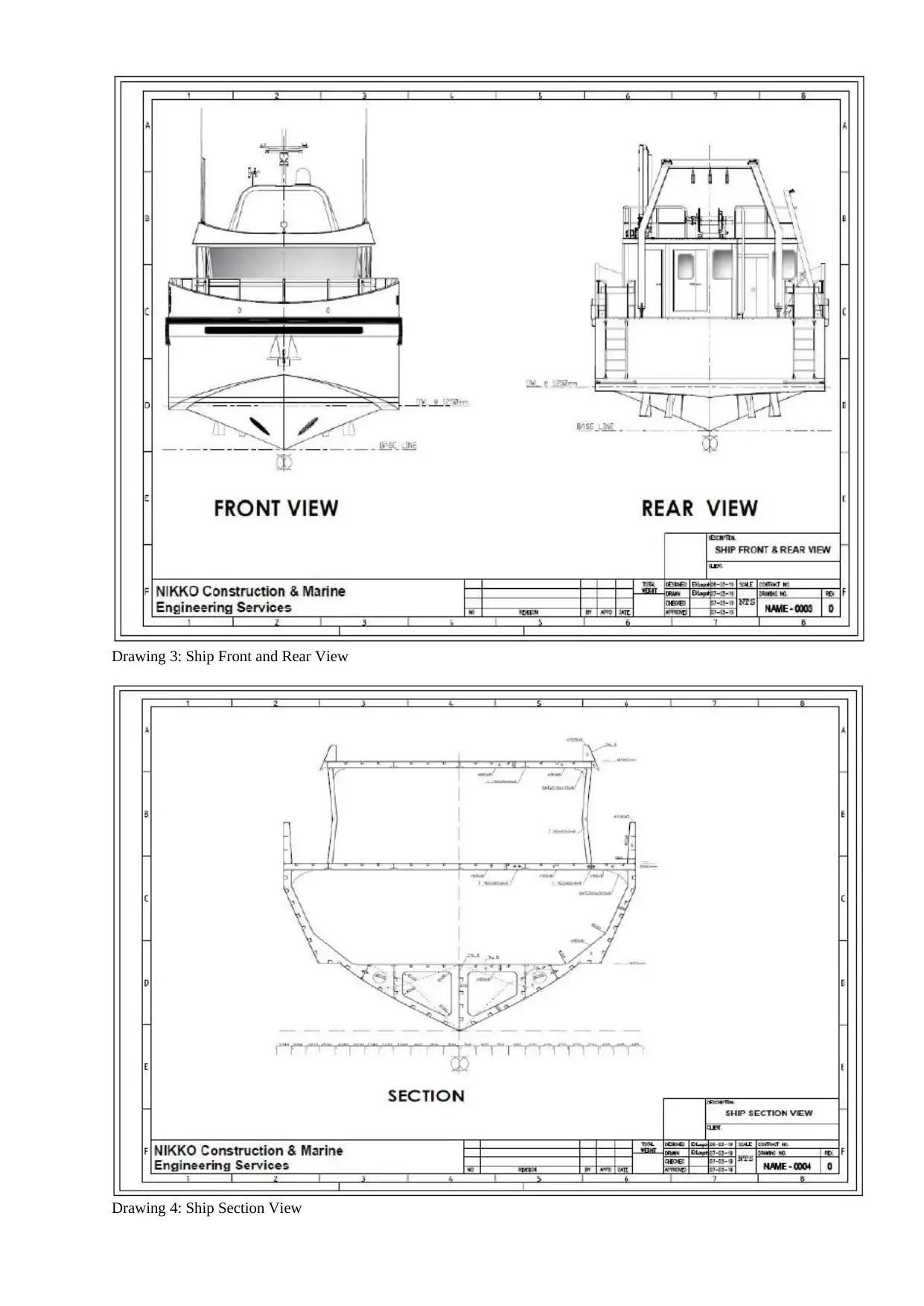
Drawing 3: Ship Front and Rear View
Drawing 4: Ship Section View
Drawing 4: Ship Section View
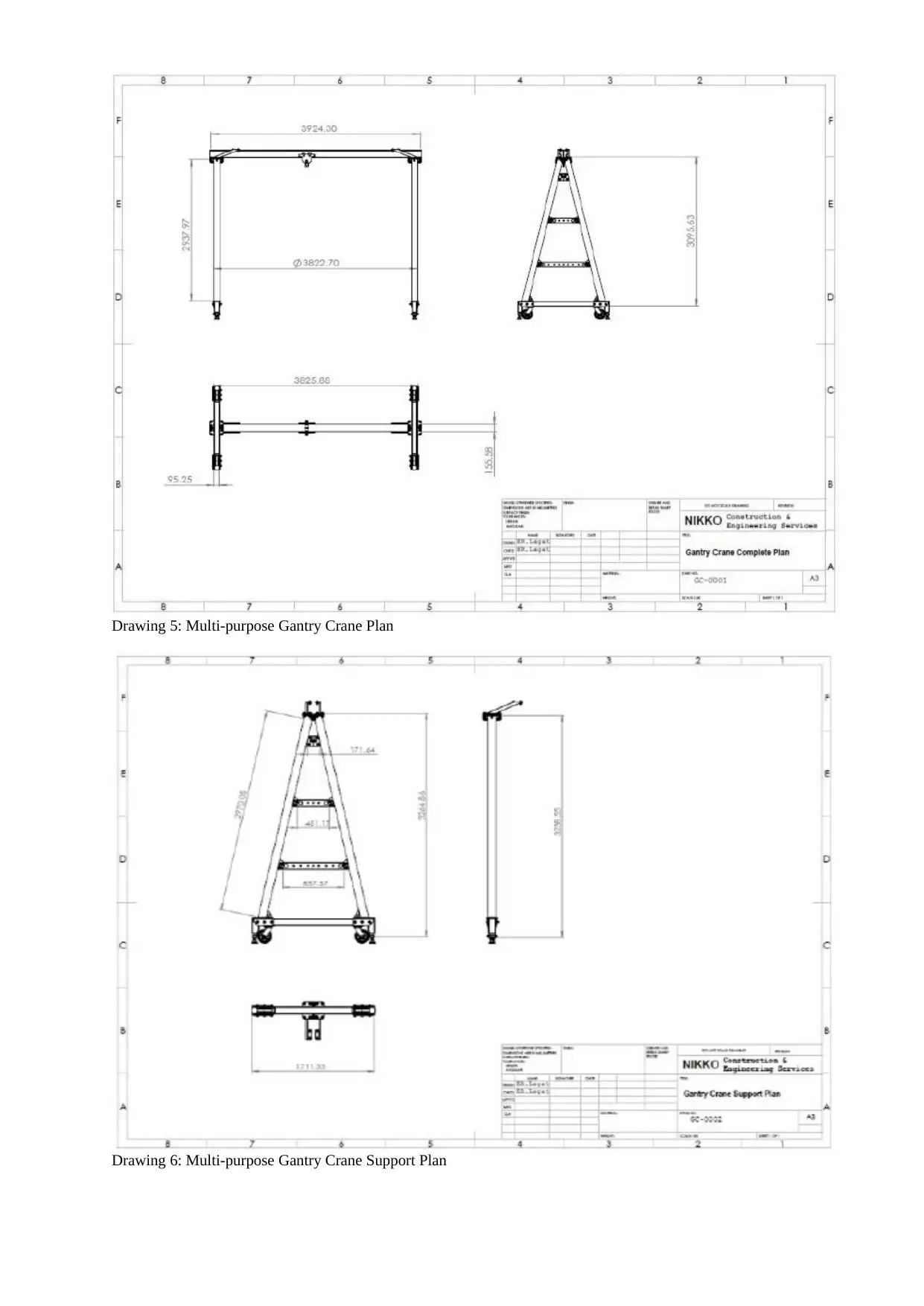
Drawing 5: Multi-purpose Gantry Crane Plan
Drawing 6: Multi-purpose Gantry Crane Support Plan
Drawing 6: Multi-purpose Gantry Crane Support Plan
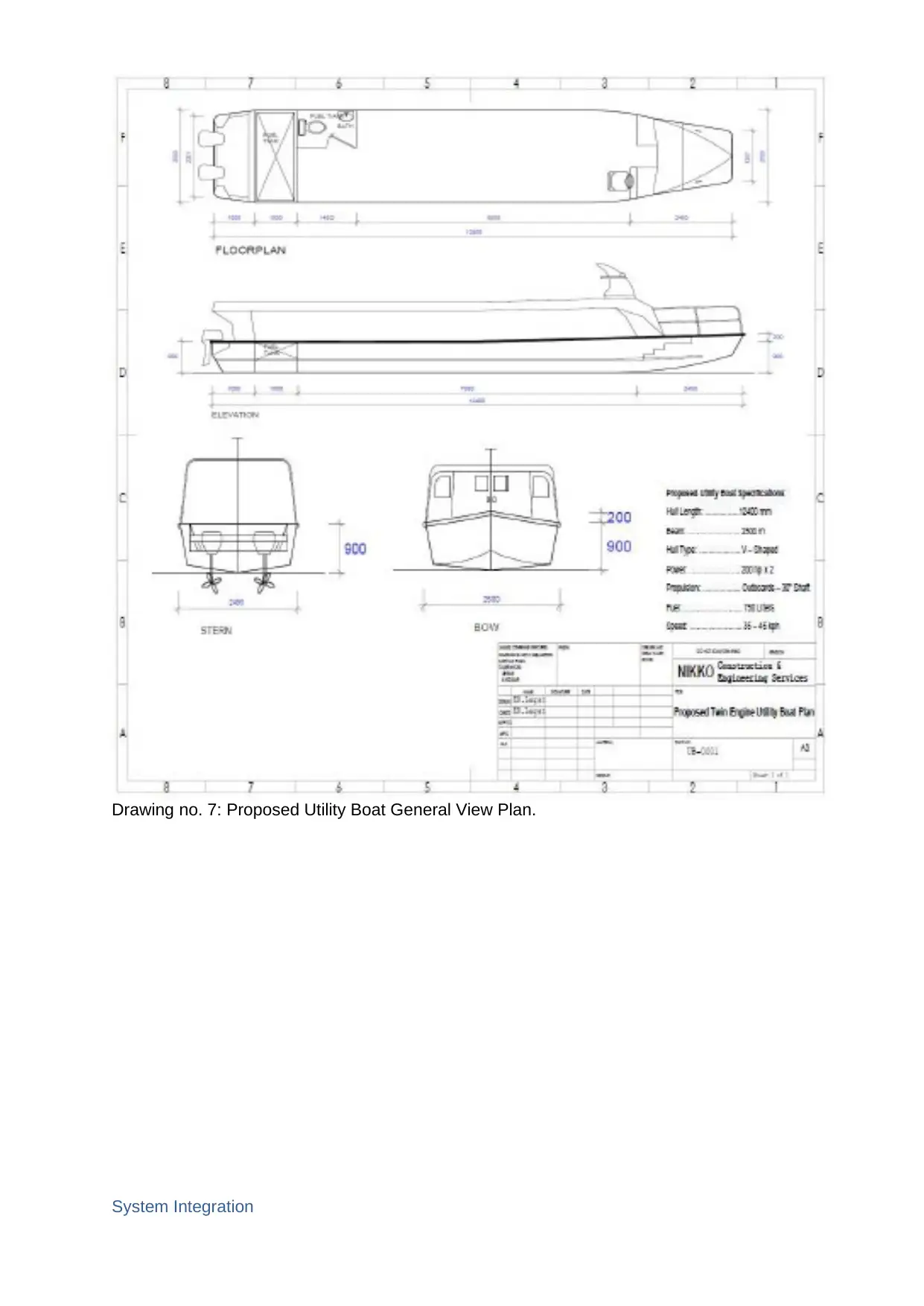
Drawing no. 7: Proposed Utility Boat General View Plan.
System Integration
System Integration
Secure Best Marks with AI Grader
Need help grading? Try our AI Grader for instant feedback on your assignments.
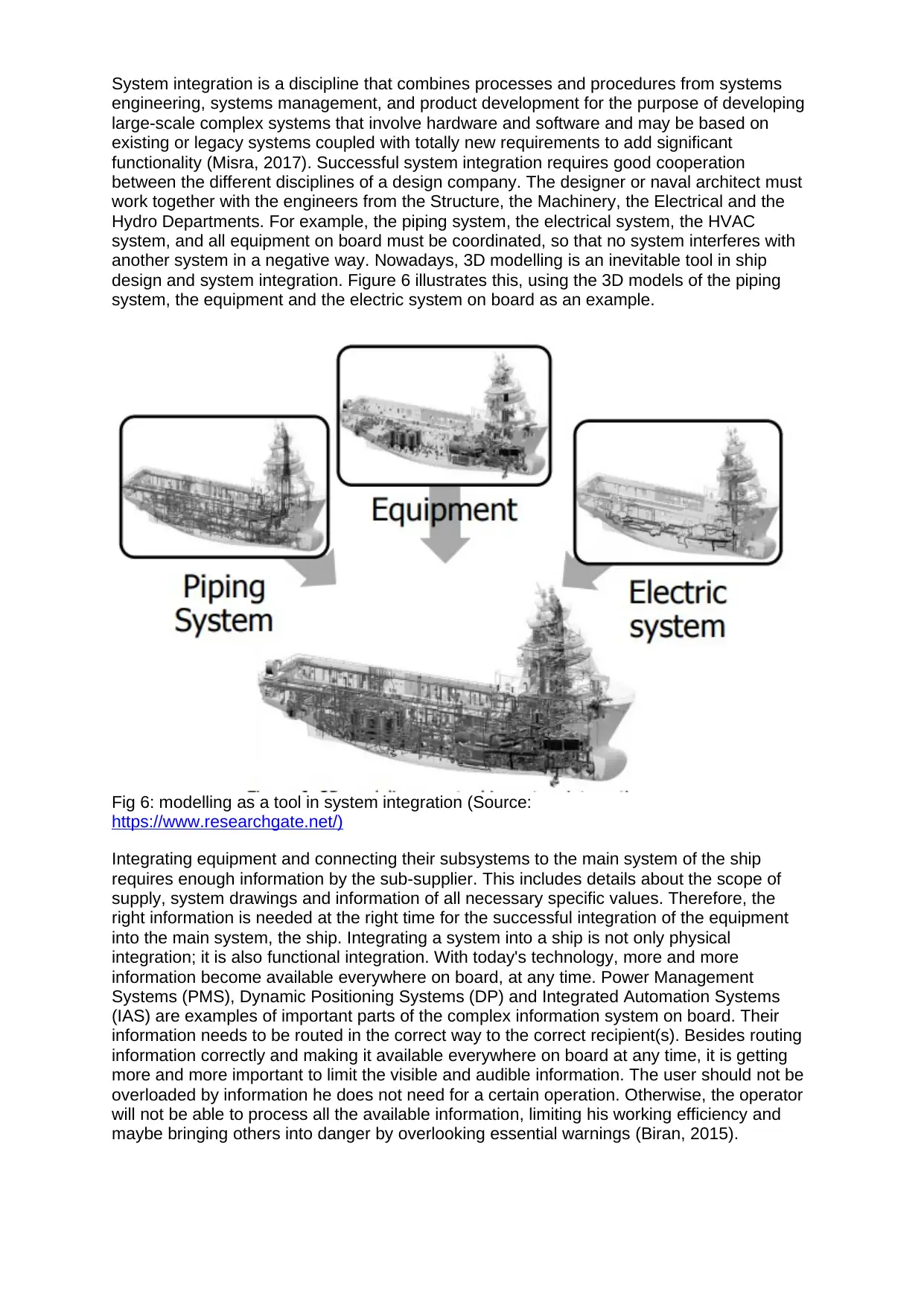
System integration is a discipline that combines processes and procedures from systems
engineering, systems management, and product development for the purpose of developing
large-scale complex systems that involve hardware and software and may be based on
existing or legacy systems coupled with totally new requirements to add significant
functionality (Misra, 2017). Successful system integration requires good cooperation
between the different disciplines of a design company. The designer or naval architect must
work together with the engineers from the Structure, the Machinery, the Electrical and the
Hydro Departments. For example, the piping system, the electrical system, the HVAC
system, and all equipment on board must be coordinated, so that no system interferes with
another system in a negative way. Nowadays, 3D modelling is an inevitable tool in ship
design and system integration. Figure 6 illustrates this, using the 3D models of the piping
system, the equipment and the electric system on board as an example.
Fig 6: modelling as a tool in system integration (Source:
https://www.researchgate.net/)
Integrating equipment and connecting their subsystems to the main system of the ship
requires enough information by the sub-supplier. This includes details about the scope of
supply, system drawings and information of all necessary specific values. Therefore, the
right information is needed at the right time for the successful integration of the equipment
into the main system, the ship. Integrating a system into a ship is not only physical
integration; it is also functional integration. With today's technology, more and more
information become available everywhere on board, at any time. Power Management
Systems (PMS), Dynamic Positioning Systems (DP) and Integrated Automation Systems
(IAS) are examples of important parts of the complex information system on board. Their
information needs to be routed in the correct way to the correct recipient(s). Besides routing
information correctly and making it available everywhere on board at any time, it is getting
more and more important to limit the visible and audible information. The user should not be
overloaded by information he does not need for a certain operation. Otherwise, the operator
will not be able to process all the available information, limiting his working efficiency and
maybe bringing others into danger by overlooking essential warnings (Biran, 2015).
engineering, systems management, and product development for the purpose of developing
large-scale complex systems that involve hardware and software and may be based on
existing or legacy systems coupled with totally new requirements to add significant
functionality (Misra, 2017). Successful system integration requires good cooperation
between the different disciplines of a design company. The designer or naval architect must
work together with the engineers from the Structure, the Machinery, the Electrical and the
Hydro Departments. For example, the piping system, the electrical system, the HVAC
system, and all equipment on board must be coordinated, so that no system interferes with
another system in a negative way. Nowadays, 3D modelling is an inevitable tool in ship
design and system integration. Figure 6 illustrates this, using the 3D models of the piping
system, the equipment and the electric system on board as an example.
Fig 6: modelling as a tool in system integration (Source:
https://www.researchgate.net/)
Integrating equipment and connecting their subsystems to the main system of the ship
requires enough information by the sub-supplier. This includes details about the scope of
supply, system drawings and information of all necessary specific values. Therefore, the
right information is needed at the right time for the successful integration of the equipment
into the main system, the ship. Integrating a system into a ship is not only physical
integration; it is also functional integration. With today's technology, more and more
information become available everywhere on board, at any time. Power Management
Systems (PMS), Dynamic Positioning Systems (DP) and Integrated Automation Systems
(IAS) are examples of important parts of the complex information system on board. Their
information needs to be routed in the correct way to the correct recipient(s). Besides routing
information correctly and making it available everywhere on board at any time, it is getting
more and more important to limit the visible and audible information. The user should not be
overloaded by information he does not need for a certain operation. Otherwise, the operator
will not be able to process all the available information, limiting his working efficiency and
maybe bringing others into danger by overlooking essential warnings (Biran, 2015).
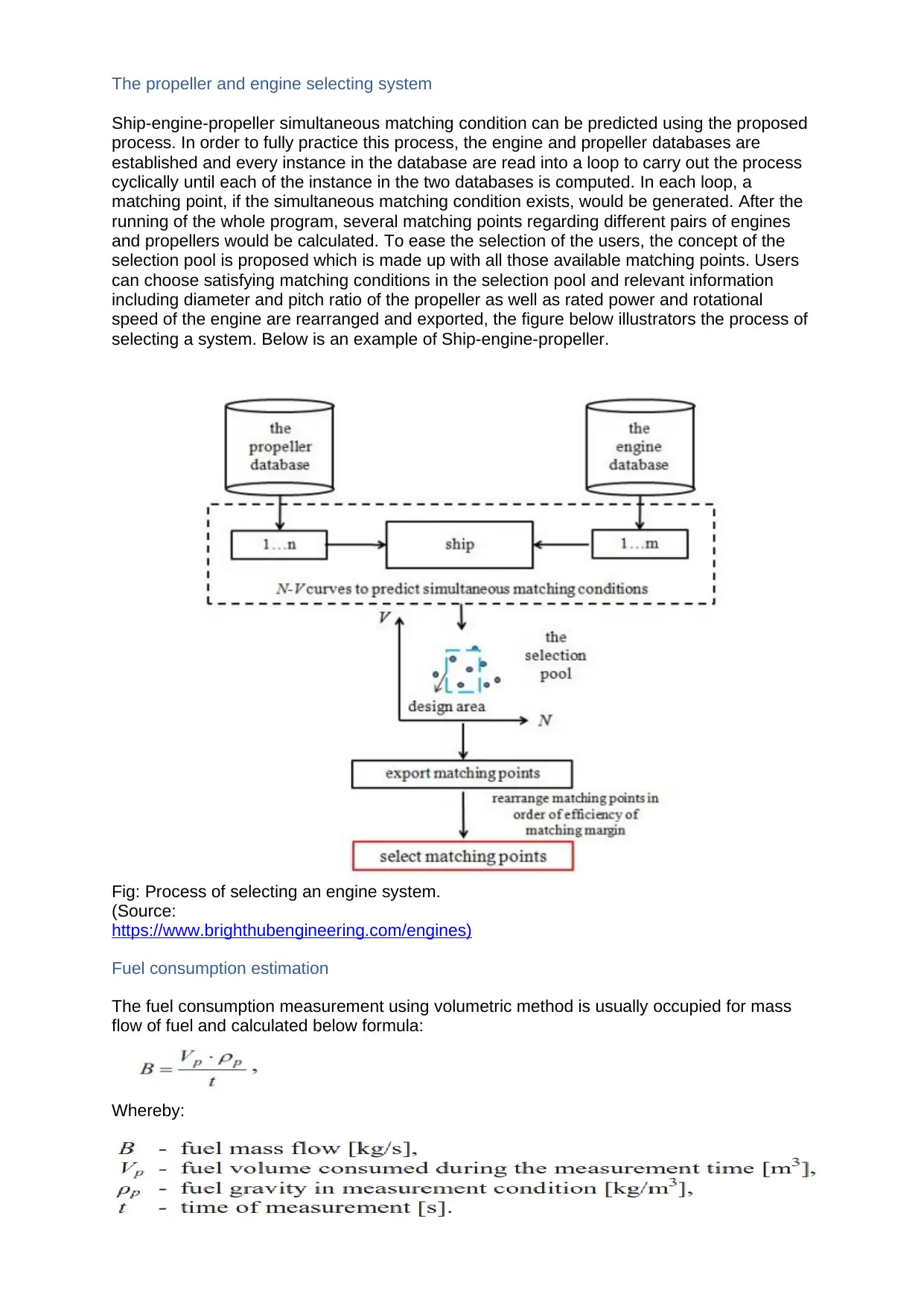
The propeller and engine selecting system
Ship-engine-propeller simultaneous matching condition can be predicted using the proposed
process. In order to fully practice this process, the engine and propeller databases are
established and every instance in the database are read into a loop to carry out the process
cyclically until each of the instance in the two databases is computed. In each loop, a
matching point, if the simultaneous matching condition exists, would be generated. After the
running of the whole program, several matching points regarding different pairs of engines
and propellers would be calculated. To ease the selection of the users, the concept of the
selection pool is proposed which is made up with all those available matching points. Users
can choose satisfying matching conditions in the selection pool and relevant information
including diameter and pitch ratio of the propeller as well as rated power and rotational
speed of the engine are rearranged and exported, the figure below illustrators the process of
selecting a system. Below is an example of Ship-engine-propeller.
Fig: Process of selecting an engine system.
(Source:
https://www.brighthubengineering.com/engines)
Fuel consumption estimation
The fuel consumption measurement using volumetric method is usually occupied for mass
flow of fuel and calculated below formula:
Whereby:
Ship-engine-propeller simultaneous matching condition can be predicted using the proposed
process. In order to fully practice this process, the engine and propeller databases are
established and every instance in the database are read into a loop to carry out the process
cyclically until each of the instance in the two databases is computed. In each loop, a
matching point, if the simultaneous matching condition exists, would be generated. After the
running of the whole program, several matching points regarding different pairs of engines
and propellers would be calculated. To ease the selection of the users, the concept of the
selection pool is proposed which is made up with all those available matching points. Users
can choose satisfying matching conditions in the selection pool and relevant information
including diameter and pitch ratio of the propeller as well as rated power and rotational
speed of the engine are rearranged and exported, the figure below illustrators the process of
selecting a system. Below is an example of Ship-engine-propeller.
Fig: Process of selecting an engine system.
(Source:
https://www.brighthubengineering.com/engines)
Fuel consumption estimation
The fuel consumption measurement using volumetric method is usually occupied for mass
flow of fuel and calculated below formula:
Whereby:
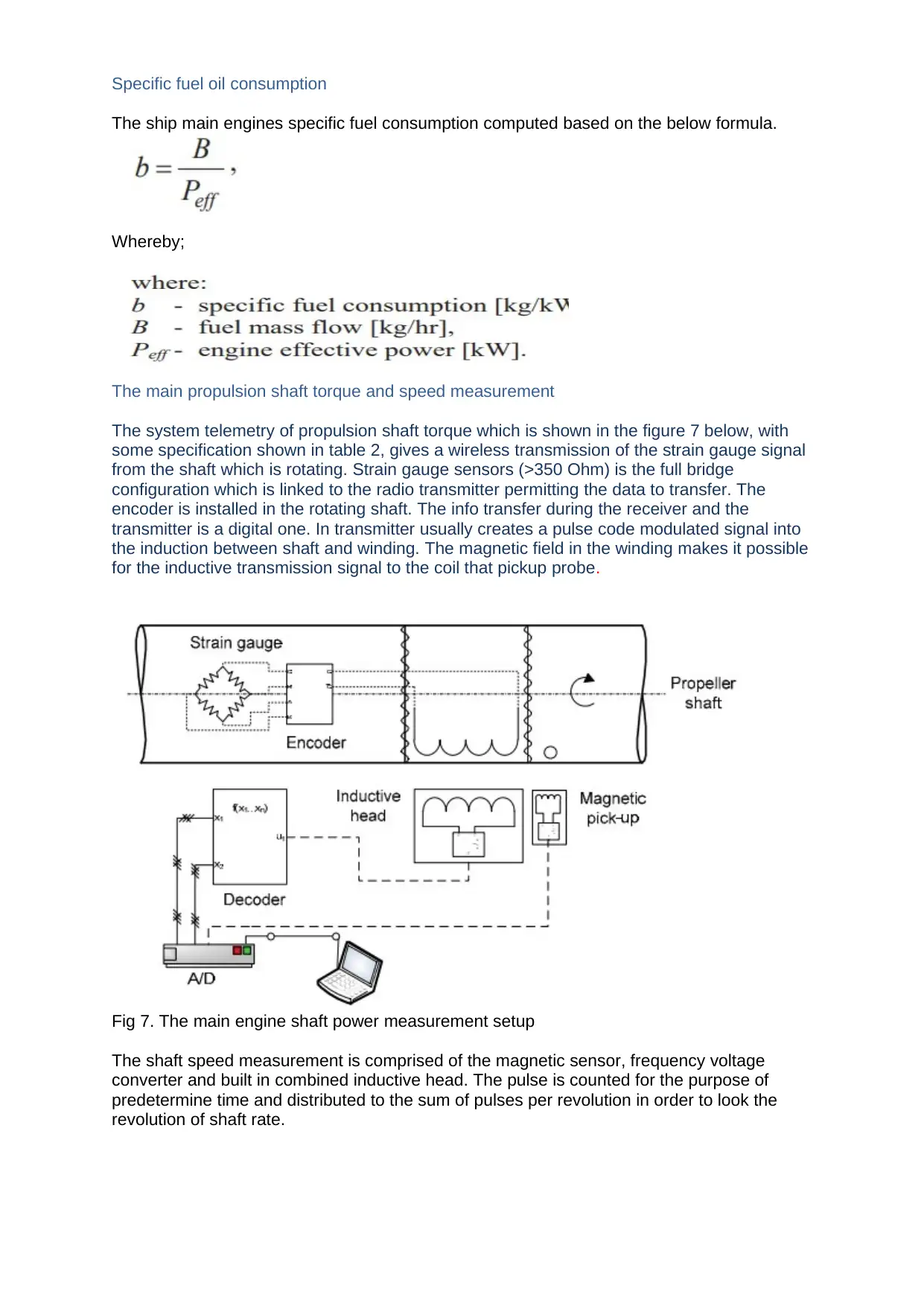
Specific fuel oil consumption
The ship main engines specific fuel consumption computed based on the below formula.
Whereby;
The main propulsion shaft torque and speed measurement
The system telemetry of propulsion shaft torque which is shown in the figure 7 below, with
some specification shown in table 2, gives a wireless transmission of the strain gauge signal
from the shaft which is rotating. Strain gauge sensors (>350 Ohm) is the full bridge
configuration which is linked to the radio transmitter permitting the data to transfer. The
encoder is installed in the rotating shaft. The info transfer during the receiver and the
transmitter is a digital one. In transmitter usually creates a pulse code modulated signal into
the induction between shaft and winding. The magnetic field in the winding makes it possible
for the inductive transmission signal to the coil that pickup probe.
Fig 7. The main engine shaft power measurement setup
The shaft speed measurement is comprised of the magnetic sensor, frequency voltage
converter and built in combined inductive head. The pulse is counted for the purpose of
predetermine time and distributed to the sum of pulses per revolution in order to look the
revolution of shaft rate.
The ship main engines specific fuel consumption computed based on the below formula.
Whereby;
The main propulsion shaft torque and speed measurement
The system telemetry of propulsion shaft torque which is shown in the figure 7 below, with
some specification shown in table 2, gives a wireless transmission of the strain gauge signal
from the shaft which is rotating. Strain gauge sensors (>350 Ohm) is the full bridge
configuration which is linked to the radio transmitter permitting the data to transfer. The
encoder is installed in the rotating shaft. The info transfer during the receiver and the
transmitter is a digital one. In transmitter usually creates a pulse code modulated signal into
the induction between shaft and winding. The magnetic field in the winding makes it possible
for the inductive transmission signal to the coil that pickup probe.
Fig 7. The main engine shaft power measurement setup
The shaft speed measurement is comprised of the magnetic sensor, frequency voltage
converter and built in combined inductive head. The pulse is counted for the purpose of
predetermine time and distributed to the sum of pulses per revolution in order to look the
revolution of shaft rate.
Paraphrase This Document
Need a fresh take? Get an instant paraphrase of this document with our AI Paraphraser
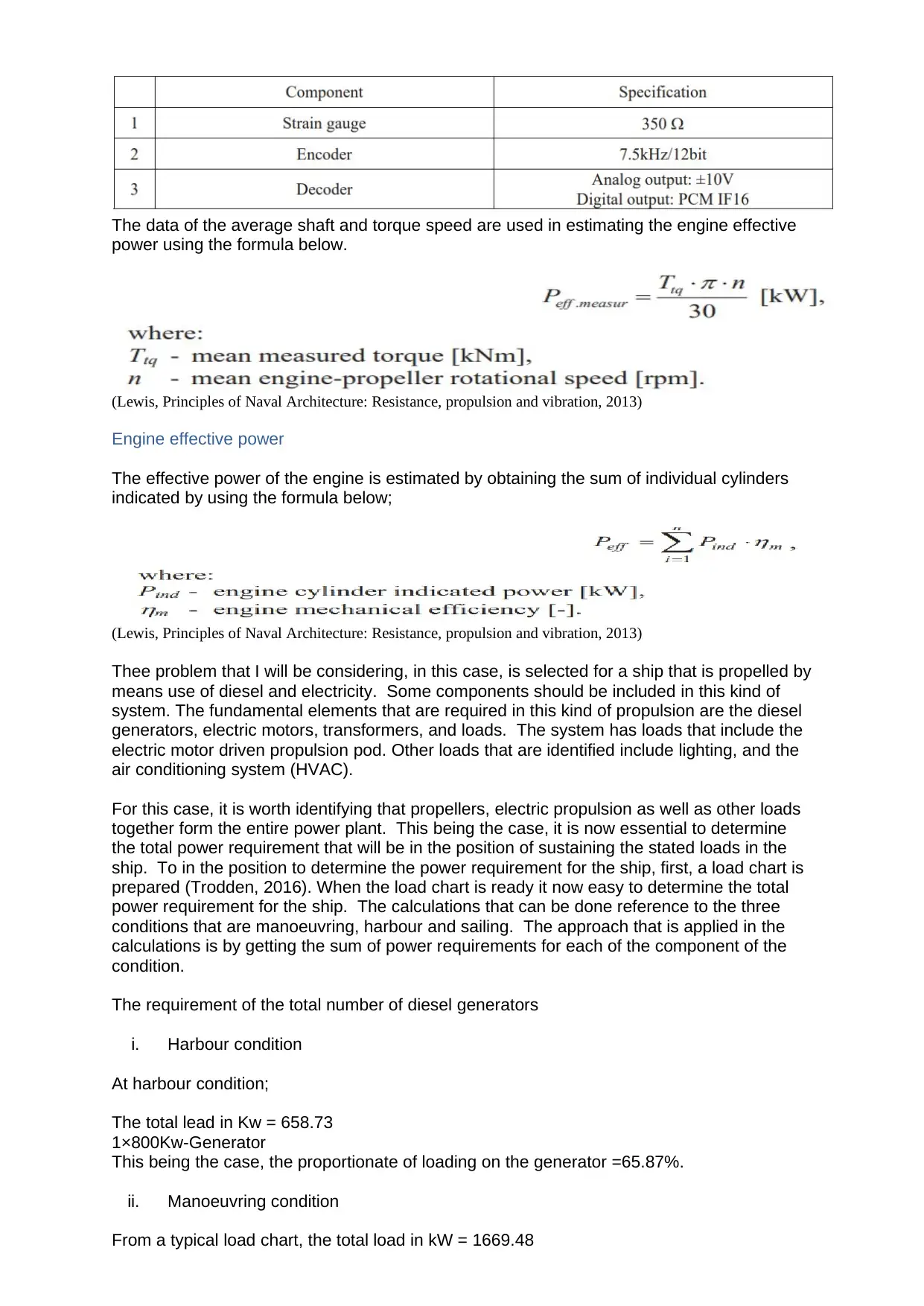
The data of the average shaft and torque speed are used in estimating the engine effective
power using the formula below.
(Lewis, Principles of Naval Architecture: Resistance, propulsion and vibration, 2013)
Engine effective power
The effective power of the engine is estimated by obtaining the sum of individual cylinders
indicated by using the formula below;
(Lewis, Principles of Naval Architecture: Resistance, propulsion and vibration, 2013)
Thee problem that I will be considering, in this case, is selected for a ship that is propelled by
means use of diesel and electricity. Some components should be included in this kind of
system. The fundamental elements that are required in this kind of propulsion are the diesel
generators, electric motors, transformers, and loads. The system has loads that include the
electric motor driven propulsion pod. Other loads that are identified include lighting, and the
air conditioning system (HVAC).
For this case, it is worth identifying that propellers, electric propulsion as well as other loads
together form the entire power plant. This being the case, it is now essential to determine
the total power requirement that will be in the position of sustaining the stated loads in the
ship. To in the position to determine the power requirement for the ship, first, a load chart is
prepared (Trodden, 2016). When the load chart is ready it now easy to determine the total
power requirement for the ship. The calculations that can be done reference to the three
conditions that are manoeuvring, harbour and sailing. The approach that is applied in the
calculations is by getting the sum of power requirements for each of the component of the
condition.
The requirement of the total number of diesel generators
i. Harbour condition
At harbour condition;
The total lead in Kw = 658.73
1×800Kw-Generator
This being the case, the proportionate of loading on the generator =65.87%.
ii. Manoeuvring condition
From a typical load chart, the total load in kW = 1669.48
power using the formula below.
(Lewis, Principles of Naval Architecture: Resistance, propulsion and vibration, 2013)
Engine effective power
The effective power of the engine is estimated by obtaining the sum of individual cylinders
indicated by using the formula below;
(Lewis, Principles of Naval Architecture: Resistance, propulsion and vibration, 2013)
Thee problem that I will be considering, in this case, is selected for a ship that is propelled by
means use of diesel and electricity. Some components should be included in this kind of
system. The fundamental elements that are required in this kind of propulsion are the diesel
generators, electric motors, transformers, and loads. The system has loads that include the
electric motor driven propulsion pod. Other loads that are identified include lighting, and the
air conditioning system (HVAC).
For this case, it is worth identifying that propellers, electric propulsion as well as other loads
together form the entire power plant. This being the case, it is now essential to determine
the total power requirement that will be in the position of sustaining the stated loads in the
ship. To in the position to determine the power requirement for the ship, first, a load chart is
prepared (Trodden, 2016). When the load chart is ready it now easy to determine the total
power requirement for the ship. The calculations that can be done reference to the three
conditions that are manoeuvring, harbour and sailing. The approach that is applied in the
calculations is by getting the sum of power requirements for each of the component of the
condition.
The requirement of the total number of diesel generators
i. Harbour condition
At harbour condition;
The total lead in Kw = 658.73
1×800Kw-Generator
This being the case, the proportionate of loading on the generator =65.87%.
ii. Manoeuvring condition
From a typical load chart, the total load in kW = 1669.48
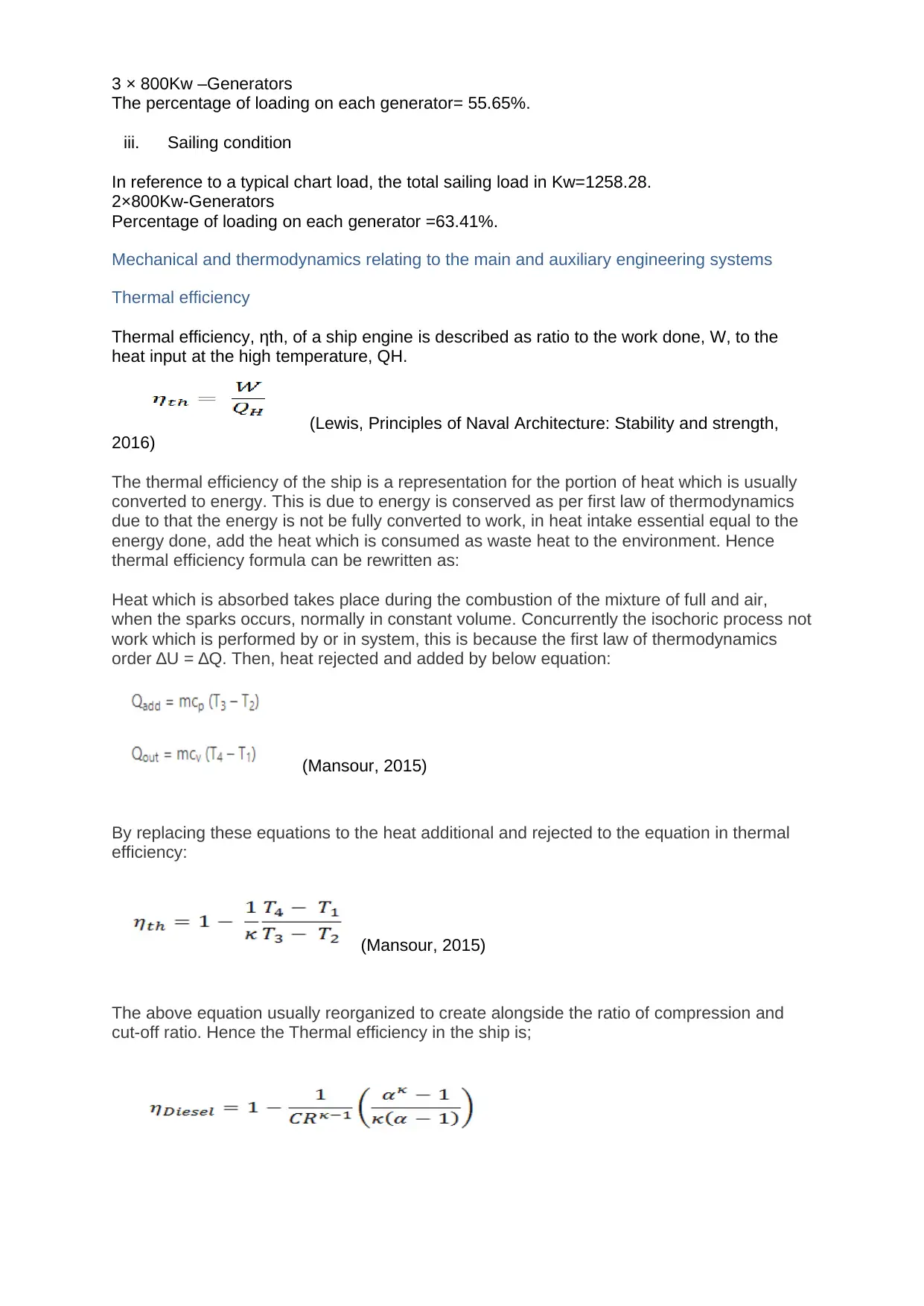
3 × 800Kw –Generators
The percentage of loading on each generator= 55.65%.
iii. Sailing condition
In reference to a typical chart load, the total sailing load in Kw=1258.28.
2×800Kw-Generators
Percentage of loading on each generator =63.41%.
Mechanical and thermodynamics relating to the main and auxiliary engineering systems
Thermal efficiency
Thermal efficiency, ηth, of a ship engine is described as ratio to the work done, W, to the
heat input at the high temperature, QH.
(Lewis, Principles of Naval Architecture: Stability and strength,
2016)
The thermal efficiency of the ship is a representation for the portion of heat which is usually
converted to energy. This is due to energy is conserved as per first law of thermodynamics
due to that the energy is not be fully converted to work, in heat intake essential equal to the
energy done, add the heat which is consumed as waste heat to the environment. Hence
thermal efficiency formula can be rewritten as:
Heat which is absorbed takes place during the combustion of the mixture of full and air,
when the sparks occurs, normally in constant volume. Concurrently the isochoric process not
work which is performed by or in system, this is because the first law of thermodynamics
order ∆U = ∆Q. Then, heat rejected and added by below equation:
(Mansour, 2015)
By replacing these equations to the heat additional and rejected to the equation in thermal
efficiency:
(Mansour, 2015)
The above equation usually reorganized to create alongside the ratio of compression and
cut-off ratio. Hence the Thermal efficiency in the ship is;
The percentage of loading on each generator= 55.65%.
iii. Sailing condition
In reference to a typical chart load, the total sailing load in Kw=1258.28.
2×800Kw-Generators
Percentage of loading on each generator =63.41%.
Mechanical and thermodynamics relating to the main and auxiliary engineering systems
Thermal efficiency
Thermal efficiency, ηth, of a ship engine is described as ratio to the work done, W, to the
heat input at the high temperature, QH.
(Lewis, Principles of Naval Architecture: Stability and strength,
2016)
The thermal efficiency of the ship is a representation for the portion of heat which is usually
converted to energy. This is due to energy is conserved as per first law of thermodynamics
due to that the energy is not be fully converted to work, in heat intake essential equal to the
energy done, add the heat which is consumed as waste heat to the environment. Hence
thermal efficiency formula can be rewritten as:
Heat which is absorbed takes place during the combustion of the mixture of full and air,
when the sparks occurs, normally in constant volume. Concurrently the isochoric process not
work which is performed by or in system, this is because the first law of thermodynamics
order ∆U = ∆Q. Then, heat rejected and added by below equation:
(Mansour, 2015)
By replacing these equations to the heat additional and rejected to the equation in thermal
efficiency:
(Mansour, 2015)
The above equation usually reorganized to create alongside the ratio of compression and
cut-off ratio. Hence the Thermal efficiency in the ship is;
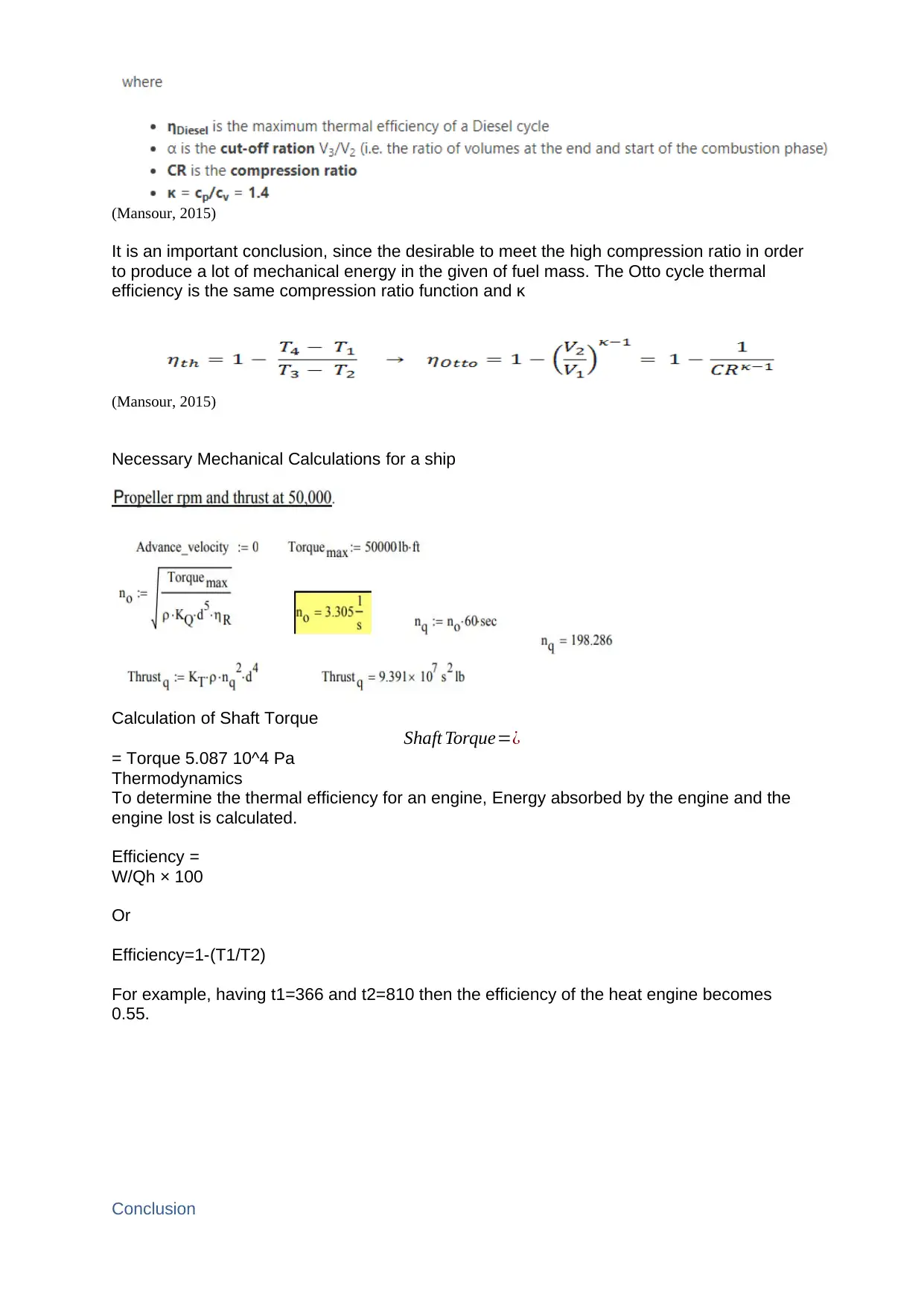
(Mansour, 2015)
It is an important conclusion, since the desirable to meet the high compression ratio in order
to produce a lot of mechanical energy in the given of fuel mass. The Otto cycle thermal
efficiency is the same compression ratio function and κ
(Mansour, 2015)
Necessary Mechanical Calculations for a ship
Calculation of Shaft Torque
Shaft Torque=¿
= Torque 5.087 10^4 Pa
Thermodynamics
To determine the thermal efficiency for an engine, Energy absorbed by the engine and the
engine lost is calculated.
Efficiency =
W/Qh × 100
Or
Efficiency=1-(T1/T2)
For example, having t1=366 and t2=810 then the efficiency of the heat engine becomes
0.55.
Conclusion
It is an important conclusion, since the desirable to meet the high compression ratio in order
to produce a lot of mechanical energy in the given of fuel mass. The Otto cycle thermal
efficiency is the same compression ratio function and κ
(Mansour, 2015)
Necessary Mechanical Calculations for a ship
Calculation of Shaft Torque
Shaft Torque=¿
= Torque 5.087 10^4 Pa
Thermodynamics
To determine the thermal efficiency for an engine, Energy absorbed by the engine and the
engine lost is calculated.
Efficiency =
W/Qh × 100
Or
Efficiency=1-(T1/T2)
For example, having t1=366 and t2=810 then the efficiency of the heat engine becomes
0.55.
Conclusion
Secure Best Marks with AI Grader
Need help grading? Try our AI Grader for instant feedback on your assignments.
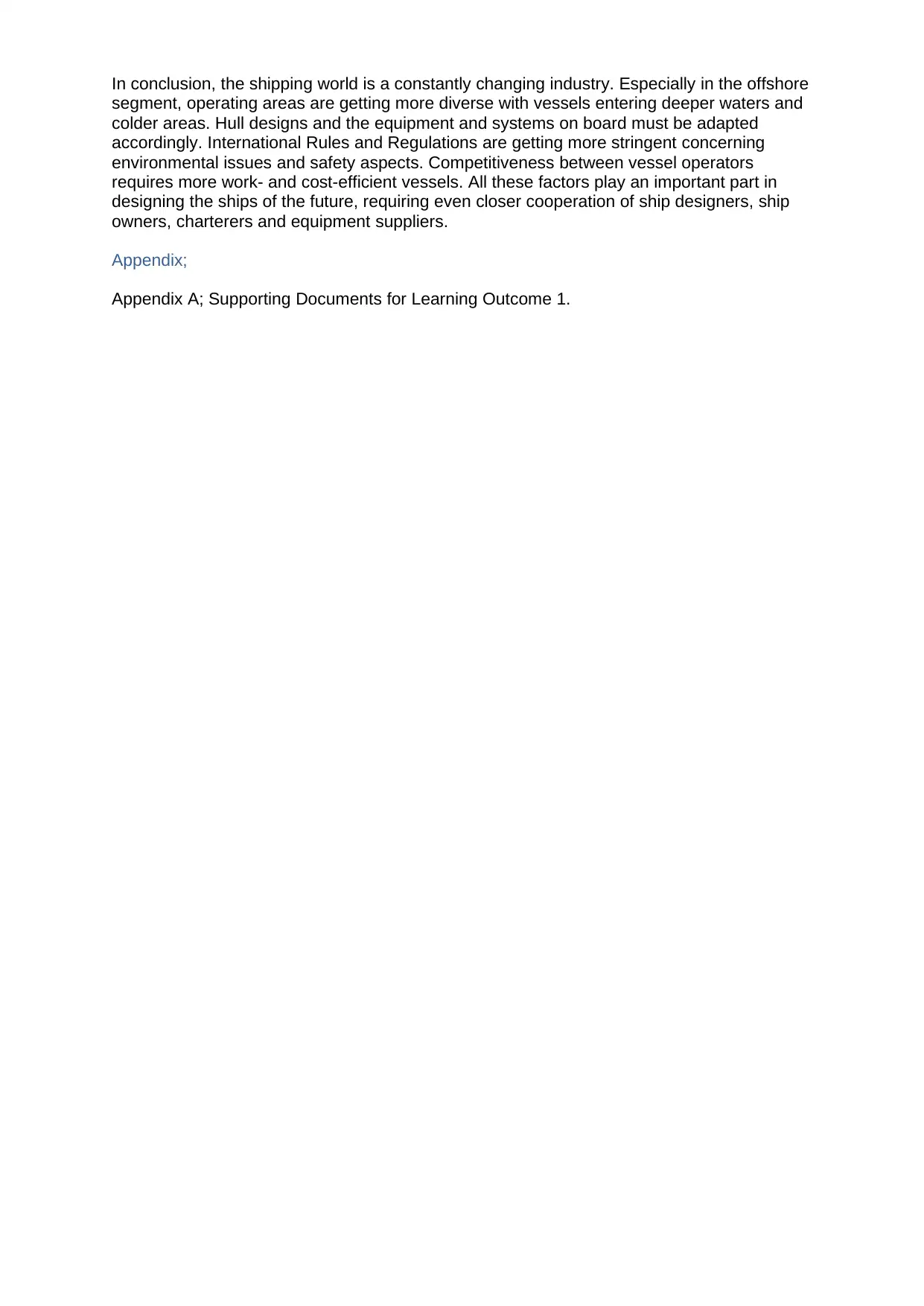
In conclusion, the shipping world is a constantly changing industry. Especially in the offshore
segment, operating areas are getting more diverse with vessels entering deeper waters and
colder areas. Hull designs and the equipment and systems on board must be adapted
accordingly. International Rules and Regulations are getting more stringent concerning
environmental issues and safety aspects. Competitiveness between vessel operators
requires more work- and cost-efficient vessels. All these factors play an important part in
designing the ships of the future, requiring even closer cooperation of ship designers, ship
owners, charterers and equipment suppliers.
Appendix;
Appendix A; Supporting Documents for Learning Outcome 1.
segment, operating areas are getting more diverse with vessels entering deeper waters and
colder areas. Hull designs and the equipment and systems on board must be adapted
accordingly. International Rules and Regulations are getting more stringent concerning
environmental issues and safety aspects. Competitiveness between vessel operators
requires more work- and cost-efficient vessels. All these factors play an important part in
designing the ships of the future, requiring even closer cooperation of ship designers, ship
owners, charterers and equipment suppliers.
Appendix;
Appendix A; Supporting Documents for Learning Outcome 1.
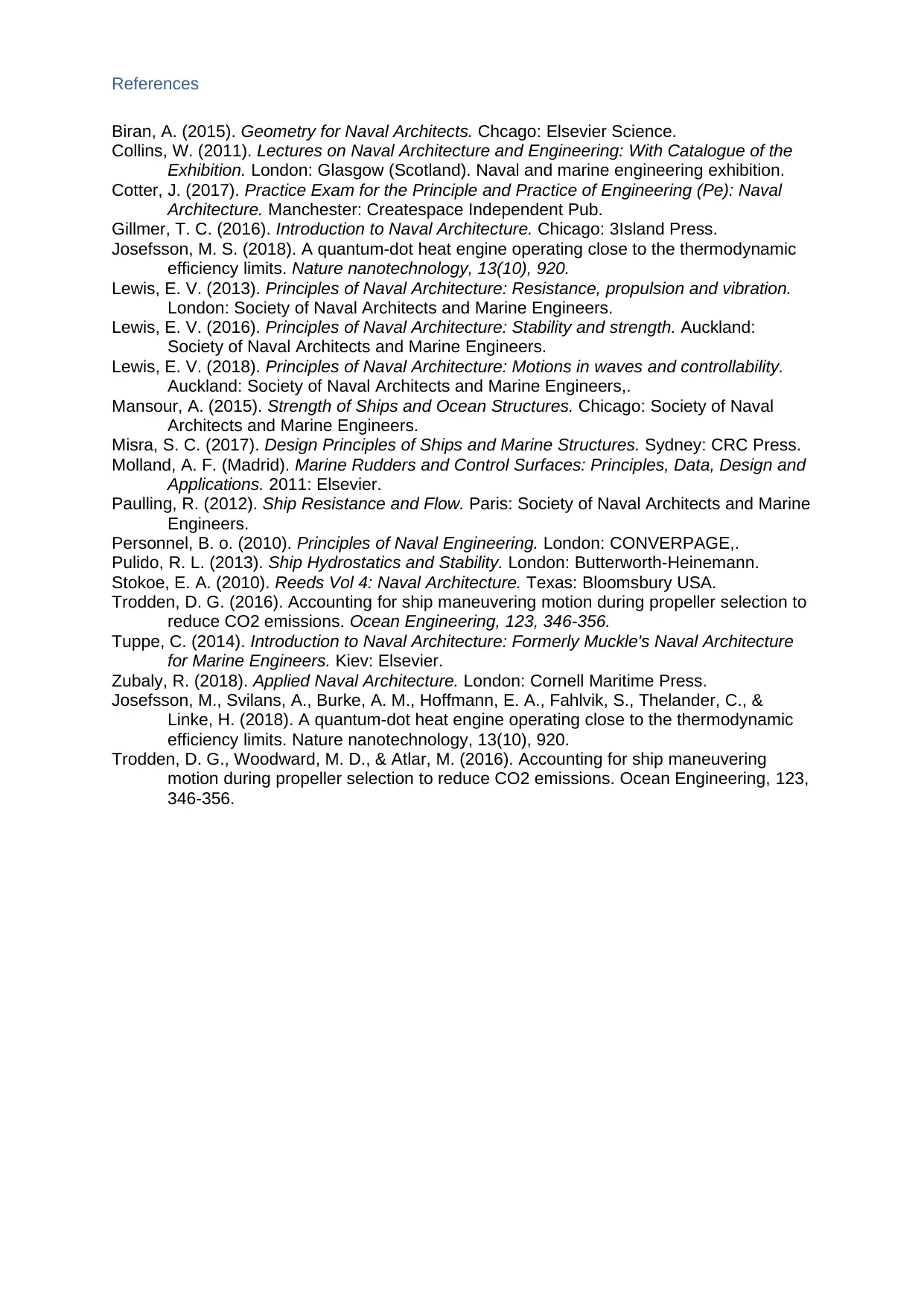
References
Biran, A. (2015). Geometry for Naval Architects. Chcago: Elsevier Science.
Collins, W. (2011). Lectures on Naval Architecture and Engineering: With Catalogue of the
Exhibition. London: Glasgow (Scotland). Naval and marine engineering exhibition.
Cotter, J. (2017). Practice Exam for the Principle and Practice of Engineering (Pe): Naval
Architecture. Manchester: Createspace Independent Pub.
Gillmer, T. C. (2016). Introduction to Naval Architecture. Chicago: 3Island Press.
Josefsson, M. S. (2018). A quantum-dot heat engine operating close to the thermodynamic
efficiency limits. Nature nanotechnology, 13(10), 920.
Lewis, E. V. (2013). Principles of Naval Architecture: Resistance, propulsion and vibration.
London: Society of Naval Architects and Marine Engineers.
Lewis, E. V. (2016). Principles of Naval Architecture: Stability and strength. Auckland:
Society of Naval Architects and Marine Engineers.
Lewis, E. V. (2018). Principles of Naval Architecture: Motions in waves and controllability.
Auckland: Society of Naval Architects and Marine Engineers,.
Mansour, A. (2015). Strength of Ships and Ocean Structures. Chicago: Society of Naval
Architects and Marine Engineers.
Misra, S. C. (2017). Design Principles of Ships and Marine Structures. Sydney: CRC Press.
Molland, A. F. (Madrid). Marine Rudders and Control Surfaces: Principles, Data, Design and
Applications. 2011: Elsevier.
Paulling, R. (2012). Ship Resistance and Flow. Paris: Society of Naval Architects and Marine
Engineers.
Personnel, B. o. (2010). Principles of Naval Engineering. London: CONVERPAGE,.
Pulido, R. L. (2013). Ship Hydrostatics and Stability. London: Butterworth-Heinemann.
Stokoe, E. A. (2010). Reeds Vol 4: Naval Architecture. Texas: Bloomsbury USA.
Trodden, D. G. (2016). Accounting for ship maneuvering motion during propeller selection to
reduce CO2 emissions. Ocean Engineering, 123, 346-356.
Tuppe, C. (2014). Introduction to Naval Architecture: Formerly Muckle's Naval Architecture
for Marine Engineers. Kiev: Elsevier.
Zubaly, R. (2018). Applied Naval Architecture. London: Cornell Maritime Press.
Josefsson, M., Svilans, A., Burke, A. M., Hoffmann, E. A., Fahlvik, S., Thelander, C., &
Linke, H. (2018). A quantum-dot heat engine operating close to the thermodynamic
efficiency limits. Nature nanotechnology, 13(10), 920.
Trodden, D. G., Woodward, M. D., & Atlar, M. (2016). Accounting for ship maneuvering
motion during propeller selection to reduce CO2 emissions. Ocean Engineering, 123,
346-356.
Biran, A. (2015). Geometry for Naval Architects. Chcago: Elsevier Science.
Collins, W. (2011). Lectures on Naval Architecture and Engineering: With Catalogue of the
Exhibition. London: Glasgow (Scotland). Naval and marine engineering exhibition.
Cotter, J. (2017). Practice Exam for the Principle and Practice of Engineering (Pe): Naval
Architecture. Manchester: Createspace Independent Pub.
Gillmer, T. C. (2016). Introduction to Naval Architecture. Chicago: 3Island Press.
Josefsson, M. S. (2018). A quantum-dot heat engine operating close to the thermodynamic
efficiency limits. Nature nanotechnology, 13(10), 920.
Lewis, E. V. (2013). Principles of Naval Architecture: Resistance, propulsion and vibration.
London: Society of Naval Architects and Marine Engineers.
Lewis, E. V. (2016). Principles of Naval Architecture: Stability and strength. Auckland:
Society of Naval Architects and Marine Engineers.
Lewis, E. V. (2018). Principles of Naval Architecture: Motions in waves and controllability.
Auckland: Society of Naval Architects and Marine Engineers,.
Mansour, A. (2015). Strength of Ships and Ocean Structures. Chicago: Society of Naval
Architects and Marine Engineers.
Misra, S. C. (2017). Design Principles of Ships and Marine Structures. Sydney: CRC Press.
Molland, A. F. (Madrid). Marine Rudders and Control Surfaces: Principles, Data, Design and
Applications. 2011: Elsevier.
Paulling, R. (2012). Ship Resistance and Flow. Paris: Society of Naval Architects and Marine
Engineers.
Personnel, B. o. (2010). Principles of Naval Engineering. London: CONVERPAGE,.
Pulido, R. L. (2013). Ship Hydrostatics and Stability. London: Butterworth-Heinemann.
Stokoe, E. A. (2010). Reeds Vol 4: Naval Architecture. Texas: Bloomsbury USA.
Trodden, D. G. (2016). Accounting for ship maneuvering motion during propeller selection to
reduce CO2 emissions. Ocean Engineering, 123, 346-356.
Tuppe, C. (2014). Introduction to Naval Architecture: Formerly Muckle's Naval Architecture
for Marine Engineers. Kiev: Elsevier.
Zubaly, R. (2018). Applied Naval Architecture. London: Cornell Maritime Press.
Josefsson, M., Svilans, A., Burke, A. M., Hoffmann, E. A., Fahlvik, S., Thelander, C., &
Linke, H. (2018). A quantum-dot heat engine operating close to the thermodynamic
efficiency limits. Nature nanotechnology, 13(10), 920.
Trodden, D. G., Woodward, M. D., & Atlar, M. (2016). Accounting for ship maneuvering
motion during propeller selection to reduce CO2 emissions. Ocean Engineering, 123,
346-356.
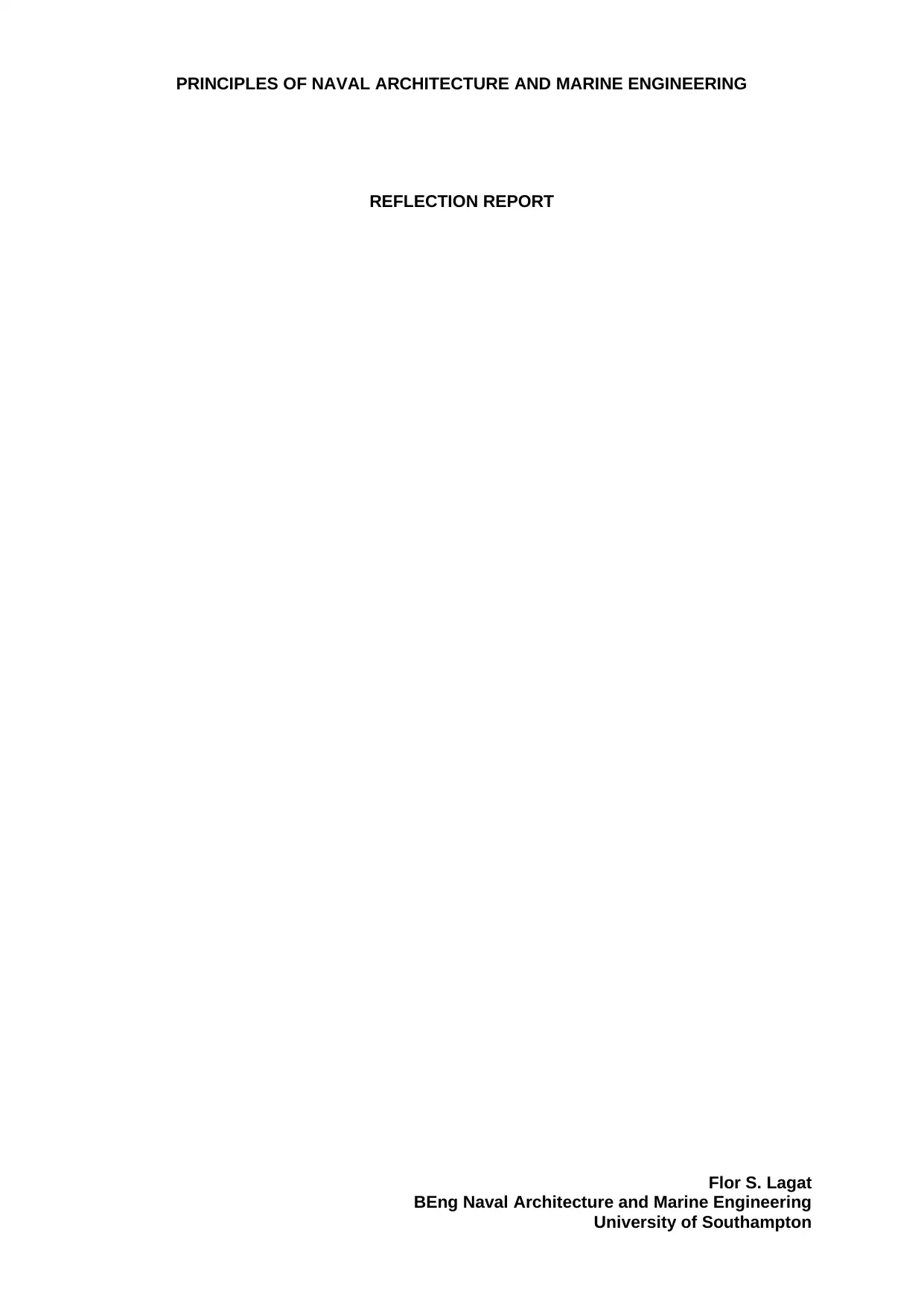
PRINCIPLES OF NAVAL ARCHITECTURE AND MARINE ENGINEERING
REFLECTION REPORT
Flor S. Lagat
BEng Naval Architecture and Marine Engineering
University of Southampton
REFLECTION REPORT
Flor S. Lagat
BEng Naval Architecture and Marine Engineering
University of Southampton
Paraphrase This Document
Need a fresh take? Get an instant paraphrase of this document with our AI Paraphraser
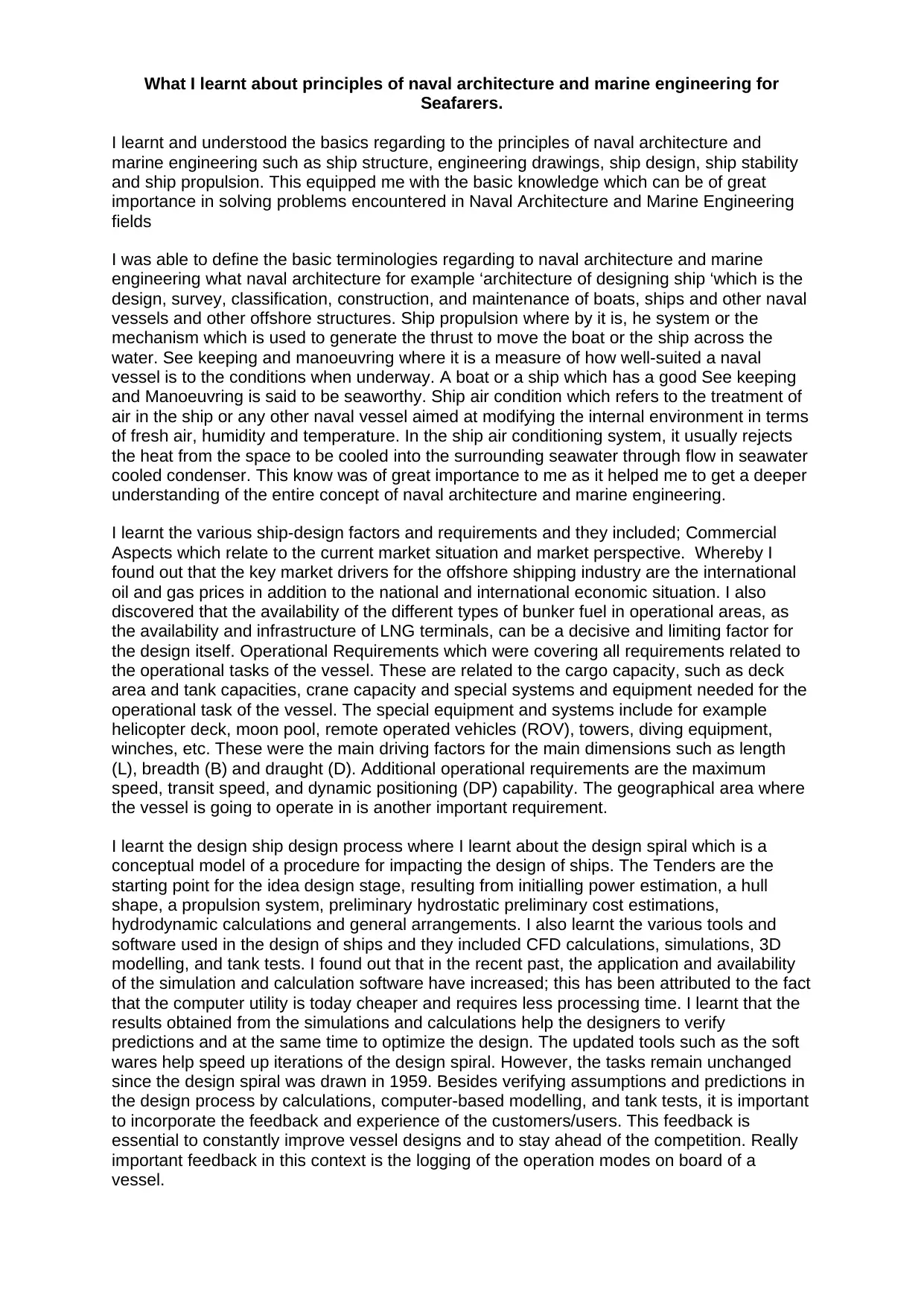
What I learnt about principles of naval architecture and marine engineering for
Seafarers.
I learnt and understood the basics regarding to the principles of naval architecture and
marine engineering such as ship structure, engineering drawings, ship design, ship stability
and ship propulsion. This equipped me with the basic knowledge which can be of great
importance in solving problems encountered in Naval Architecture and Marine Engineering
fields
I was able to define the basic terminologies regarding to naval architecture and marine
engineering what naval architecture for example ‘architecture of designing ship ‘which is the
design, survey, classification, construction, and maintenance of boats, ships and other naval
vessels and other offshore structures. Ship propulsion where by it is, he system or the
mechanism which is used to generate the thrust to move the boat or the ship across the
water. See keeping and manoeuvring where it is a measure of how well-suited a naval
vessel is to the conditions when underway. A boat or a ship which has a good See keeping
and Manoeuvring is said to be seaworthy. Ship air condition which refers to the treatment of
air in the ship or any other naval vessel aimed at modifying the internal environment in terms
of fresh air, humidity and temperature. In the ship air conditioning system, it usually rejects
the heat from the space to be cooled into the surrounding seawater through flow in seawater
cooled condenser. This know was of great importance to me as it helped me to get a deeper
understanding of the entire concept of naval architecture and marine engineering.
I learnt the various ship-design factors and requirements and they included; Commercial
Aspects which relate to the current market situation and market perspective. Whereby I
found out that the key market drivers for the offshore shipping industry are the international
oil and gas prices in addition to the national and international economic situation. I also
discovered that the availability of the different types of bunker fuel in operational areas, as
the availability and infrastructure of LNG terminals, can be a decisive and limiting factor for
the design itself. Operational Requirements which were covering all requirements related to
the operational tasks of the vessel. These are related to the cargo capacity, such as deck
area and tank capacities, crane capacity and special systems and equipment needed for the
operational task of the vessel. The special equipment and systems include for example
helicopter deck, moon pool, remote operated vehicles (ROV), towers, diving equipment,
winches, etc. These were the main driving factors for the main dimensions such as length
(L), breadth (B) and draught (D). Additional operational requirements are the maximum
speed, transit speed, and dynamic positioning (DP) capability. The geographical area where
the vessel is going to operate in is another important requirement.
I learnt the design ship design process where I learnt about the design spiral which is a
conceptual model of a procedure for impacting the design of ships. The Tenders are the
starting point for the idea design stage, resulting from initialling power estimation, a hull
shape, a propulsion system, preliminary hydrostatic preliminary cost estimations,
hydrodynamic calculations and general arrangements. I also learnt the various tools and
software used in the design of ships and they included CFD calculations, simulations, 3D
modelling, and tank tests. I found out that in the recent past, the application and availability
of the simulation and calculation software have increased; this has been attributed to the fact
that the computer utility is today cheaper and requires less processing time. I learnt that the
results obtained from the simulations and calculations help the designers to verify
predictions and at the same time to optimize the design. The updated tools such as the soft
wares help speed up iterations of the design spiral. However, the tasks remain unchanged
since the design spiral was drawn in 1959. Besides verifying assumptions and predictions in
the design process by calculations, computer-based modelling, and tank tests, it is important
to incorporate the feedback and experience of the customers/users. This feedback is
essential to constantly improve vessel designs and to stay ahead of the competition. Really
important feedback in this context is the logging of the operation modes on board of a
vessel.
Seafarers.
I learnt and understood the basics regarding to the principles of naval architecture and
marine engineering such as ship structure, engineering drawings, ship design, ship stability
and ship propulsion. This equipped me with the basic knowledge which can be of great
importance in solving problems encountered in Naval Architecture and Marine Engineering
fields
I was able to define the basic terminologies regarding to naval architecture and marine
engineering what naval architecture for example ‘architecture of designing ship ‘which is the
design, survey, classification, construction, and maintenance of boats, ships and other naval
vessels and other offshore structures. Ship propulsion where by it is, he system or the
mechanism which is used to generate the thrust to move the boat or the ship across the
water. See keeping and manoeuvring where it is a measure of how well-suited a naval
vessel is to the conditions when underway. A boat or a ship which has a good See keeping
and Manoeuvring is said to be seaworthy. Ship air condition which refers to the treatment of
air in the ship or any other naval vessel aimed at modifying the internal environment in terms
of fresh air, humidity and temperature. In the ship air conditioning system, it usually rejects
the heat from the space to be cooled into the surrounding seawater through flow in seawater
cooled condenser. This know was of great importance to me as it helped me to get a deeper
understanding of the entire concept of naval architecture and marine engineering.
I learnt the various ship-design factors and requirements and they included; Commercial
Aspects which relate to the current market situation and market perspective. Whereby I
found out that the key market drivers for the offshore shipping industry are the international
oil and gas prices in addition to the national and international economic situation. I also
discovered that the availability of the different types of bunker fuel in operational areas, as
the availability and infrastructure of LNG terminals, can be a decisive and limiting factor for
the design itself. Operational Requirements which were covering all requirements related to
the operational tasks of the vessel. These are related to the cargo capacity, such as deck
area and tank capacities, crane capacity and special systems and equipment needed for the
operational task of the vessel. The special equipment and systems include for example
helicopter deck, moon pool, remote operated vehicles (ROV), towers, diving equipment,
winches, etc. These were the main driving factors for the main dimensions such as length
(L), breadth (B) and draught (D). Additional operational requirements are the maximum
speed, transit speed, and dynamic positioning (DP) capability. The geographical area where
the vessel is going to operate in is another important requirement.
I learnt the design ship design process where I learnt about the design spiral which is a
conceptual model of a procedure for impacting the design of ships. The Tenders are the
starting point for the idea design stage, resulting from initialling power estimation, a hull
shape, a propulsion system, preliminary hydrostatic preliminary cost estimations,
hydrodynamic calculations and general arrangements. I also learnt the various tools and
software used in the design of ships and they included CFD calculations, simulations, 3D
modelling, and tank tests. I found out that in the recent past, the application and availability
of the simulation and calculation software have increased; this has been attributed to the fact
that the computer utility is today cheaper and requires less processing time. I learnt that the
results obtained from the simulations and calculations help the designers to verify
predictions and at the same time to optimize the design. The updated tools such as the soft
wares help speed up iterations of the design spiral. However, the tasks remain unchanged
since the design spiral was drawn in 1959. Besides verifying assumptions and predictions in
the design process by calculations, computer-based modelling, and tank tests, it is important
to incorporate the feedback and experience of the customers/users. This feedback is
essential to constantly improve vessel designs and to stay ahead of the competition. Really
important feedback in this context is the logging of the operation modes on board of a
vessel.
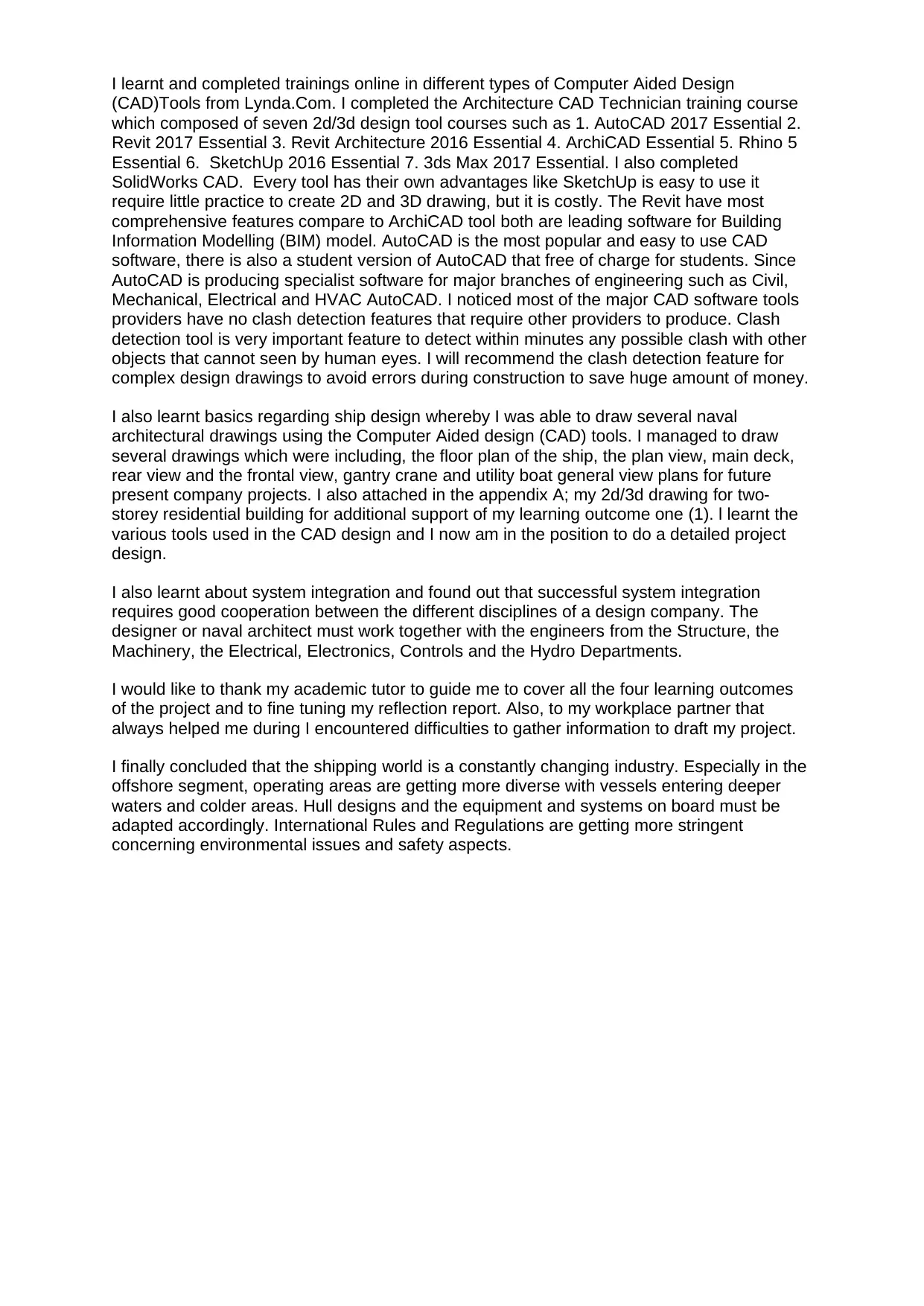
I learnt and completed trainings online in different types of Computer Aided Design
(CAD)Tools from Lynda.Com. I completed the Architecture CAD Technician training course
which composed of seven 2d/3d design tool courses such as 1. AutoCAD 2017 Essential 2.
Revit 2017 Essential 3. Revit Architecture 2016 Essential 4. ArchiCAD Essential 5. Rhino 5
Essential 6. SketchUp 2016 Essential 7. 3ds Max 2017 Essential. I also completed
SolidWorks CAD. Every tool has their own advantages like SketchUp is easy to use it
require little practice to create 2D and 3D drawing, but it is costly. The Revit have most
comprehensive features compare to ArchiCAD tool both are leading software for Building
Information Modelling (BIM) model. AutoCAD is the most popular and easy to use CAD
software, there is also a student version of AutoCAD that free of charge for students. Since
AutoCAD is producing specialist software for major branches of engineering such as Civil,
Mechanical, Electrical and HVAC AutoCAD. I noticed most of the major CAD software tools
providers have no clash detection features that require other providers to produce. Clash
detection tool is very important feature to detect within minutes any possible clash with other
objects that cannot seen by human eyes. I will recommend the clash detection feature for
complex design drawings to avoid errors during construction to save huge amount of money.
I also learnt basics regarding ship design whereby I was able to draw several naval
architectural drawings using the Computer Aided design (CAD) tools. I managed to draw
several drawings which were including, the floor plan of the ship, the plan view, main deck,
rear view and the frontal view, gantry crane and utility boat general view plans for future
present company projects. I also attached in the appendix A; my 2d/3d drawing for two-
storey residential building for additional support of my learning outcome one (1). l learnt the
various tools used in the CAD design and I now am in the position to do a detailed project
design.
I also learnt about system integration and found out that successful system integration
requires good cooperation between the different disciplines of a design company. The
designer or naval architect must work together with the engineers from the Structure, the
Machinery, the Electrical, Electronics, Controls and the Hydro Departments.
I would like to thank my academic tutor to guide me to cover all the four learning outcomes
of the project and to fine tuning my reflection report. Also, to my workplace partner that
always helped me during I encountered difficulties to gather information to draft my project.
I finally concluded that the shipping world is a constantly changing industry. Especially in the
offshore segment, operating areas are getting more diverse with vessels entering deeper
waters and colder areas. Hull designs and the equipment and systems on board must be
adapted accordingly. International Rules and Regulations are getting more stringent
concerning environmental issues and safety aspects.
(CAD)Tools from Lynda.Com. I completed the Architecture CAD Technician training course
which composed of seven 2d/3d design tool courses such as 1. AutoCAD 2017 Essential 2.
Revit 2017 Essential 3. Revit Architecture 2016 Essential 4. ArchiCAD Essential 5. Rhino 5
Essential 6. SketchUp 2016 Essential 7. 3ds Max 2017 Essential. I also completed
SolidWorks CAD. Every tool has their own advantages like SketchUp is easy to use it
require little practice to create 2D and 3D drawing, but it is costly. The Revit have most
comprehensive features compare to ArchiCAD tool both are leading software for Building
Information Modelling (BIM) model. AutoCAD is the most popular and easy to use CAD
software, there is also a student version of AutoCAD that free of charge for students. Since
AutoCAD is producing specialist software for major branches of engineering such as Civil,
Mechanical, Electrical and HVAC AutoCAD. I noticed most of the major CAD software tools
providers have no clash detection features that require other providers to produce. Clash
detection tool is very important feature to detect within minutes any possible clash with other
objects that cannot seen by human eyes. I will recommend the clash detection feature for
complex design drawings to avoid errors during construction to save huge amount of money.
I also learnt basics regarding ship design whereby I was able to draw several naval
architectural drawings using the Computer Aided design (CAD) tools. I managed to draw
several drawings which were including, the floor plan of the ship, the plan view, main deck,
rear view and the frontal view, gantry crane and utility boat general view plans for future
present company projects. I also attached in the appendix A; my 2d/3d drawing for two-
storey residential building for additional support of my learning outcome one (1). l learnt the
various tools used in the CAD design and I now am in the position to do a detailed project
design.
I also learnt about system integration and found out that successful system integration
requires good cooperation between the different disciplines of a design company. The
designer or naval architect must work together with the engineers from the Structure, the
Machinery, the Electrical, Electronics, Controls and the Hydro Departments.
I would like to thank my academic tutor to guide me to cover all the four learning outcomes
of the project and to fine tuning my reflection report. Also, to my workplace partner that
always helped me during I encountered difficulties to gather information to draft my project.
I finally concluded that the shipping world is a constantly changing industry. Especially in the
offshore segment, operating areas are getting more diverse with vessels entering deeper
waters and colder areas. Hull designs and the equipment and systems on board must be
adapted accordingly. International Rules and Regulations are getting more stringent
concerning environmental issues and safety aspects.
1 out of 27
Related Documents
Your All-in-One AI-Powered Toolkit for Academic Success.
+13062052269
info@desklib.com
Available 24*7 on WhatsApp / Email
![[object Object]](/_next/static/media/star-bottom.7253800d.svg)
Unlock your academic potential
© 2024 | Zucol Services PVT LTD | All rights reserved.




